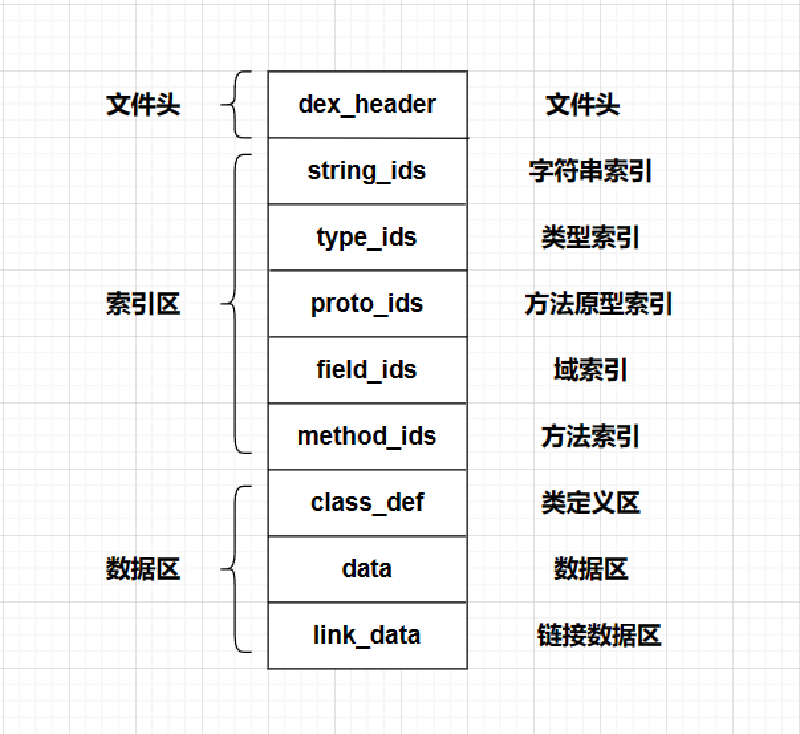前言
近期学习DEX文件结构为学习APP加壳脱壳打基础,自实现了一个简易的DEX解析器加深理解
DEX文件结构整体看不复杂,深究时发现DexCLassDef结构非常复杂,编码的数据结构,嵌套和指向关系
本文作为近期学习的一个阶段总结以及知识分享,后期再完善Todo部分
由于本人水平有限,文章错漏之处还望大佬批评指正
环境&工具:
准备
自行编译dex文件供后续分析
1
2
3
4
5
|
public class HelloDEX{
public static void main(String[] args){
System.out.println("Hello Dex!");
}
}
|
1
2
|
javac HelloDEX.java
d8 HelloDEX.class
|
可能遇到报错如下,这是因为d8需要java11+的环境,不支持java8
1
2
|
Error: A JNI error has occurred, please check your installation and try again
Exception in thread "main" java.lang.UnsupportedClassVersionError: com/android/tools/r8/D8 has been compiled by a more recent version of the Java Runtime (class file version 55.0), this version of the Java Runtime only recognizes class file versions up to 52.0
|
数据类型
Android源码 http://androidxref.com/2.3.7/xref/dalvik/libdex/DexFile.h 定义了dex文件用到的数据结构
| 自定义类型 |
原类型 |
含义 |
| s1 |
int8_t |
有符号单字节 |
| u1 |
uint8_t |
无符号单字节 |
| s2 |
int16_t |
|
| u2 |
uint16_t |
|
| s4 |
int32_t |
|
| u4 |
uint32_t |
|
| s8 |
int64_t |
|
| u8 |
uint64_t |
|
| sleb128 |
无 |
有符号LEB128,可变长度 |
| uleb128 |
无 |
无符号LEB128,可变长度 |
| uleb128p1 |
无 |
等于ULEB128加1,可变长度 |
Leb128
sleb128、uleb128、uleb128p1是Dex文件中特有的LEB128类型.在下述Android源码位置可以找到LEB128的实现.http://androidxref.com/2.3.7/xref/dalvik/libdex/Leb128.h
每个LEB128由1-5字节组成,所有字节组合在一起表示一个32位的数据, 每个字节只有低7位为有效位,最高位标识是否需要使用额外字节
如果第1个字节的最高位为1,表示LEB128需要使用第2个字节,如果第2个字节的最高位为1,表示会使用第3个字节,依次类推,直到最后一个字节的最高位为0
uleb128读取代码如下
值得注意的是参数为二级指针,也就是说,调用该函数时会移动一级指针,一级指针的偏移量即为读取到的uleb128的大小
1
2
3
4
5
6
7
8
9
10
11
12
13
14
15
16
17
18
19
20
21
22
23
24
25
26
27
28
29
|
int readUnsignedLeb128(const u1** pStream) {
const u1* ptr = *pStream;
int result = *(ptr++);
if (result > 0x7f) {
int cur = *(ptr++);
result = (result & 0x7f) | ((cur & 0x7f) << 7);
if (cur > 0x7f) {
cur = *(ptr++);
result |= (cur & 0x7f) << 14;
if (cur > 0x7f) {
cur = *(ptr++);
result |= (cur & 0x7f) << 21;
if (cur > 0x7f) {
/*
* Note: We don't check to see if cur is out of
* range here, meaning we tolerate garbage in the
* high four-order bits.
*/
cur = *(ptr++);
result |= cur << 28;
}
}
}
}
*pStream = ptr;
return result;
}
|
为方便使用自定义了myReadUnsignedLeb128函数,参数为一级指针,返回读取的数据及其大小
1
2
3
4
5
6
7
8
|
// 传入指针直接读取数据并返回数据和读取的大小(可选)
int myReadUnsignedLeb128(const u1* pData,size_t* readSize) {
const u1** pStream = &pData;
u4 result=readUnsignedLeb128(pStream);
if(readSize)
*readSize=unsignedLeb128Size(result);
return result;
}
|
encoded_value
参考Android官方文档https://source.android.com/docs/core/dalvik/dex-format?hl=zh-cn#encoding
解析代码参考以下文档,只找到了java代码
http://androidxref.com/2.3.7/xref/cts/tools/dex-tools/src/dex/reader/DexEncodedValueImpl.java
http://androidxref.com/2.3.7/xref/dalvik/dx/src/com/android/dx/dex/file/ValueEncoder.java
解析DexClassDef结构时,Annotation的annotation_element和encoded_array_item会使用该编码
编码格式如下,1字节的头用于指定value格式和大小,后续紧跟数据,需要根据类型解析
| 名称 |
格式 |
说明 |
| (value_arg « 5) | value_type |
ubyte |
高3位为value_arg的值,低5位为value_type的值,value_type指定value的格式。 |
| value |
ubyte[] |
用于表示值的字节,不同 value_type 字节的长度不同且采用不同的解译方式;不过一律采用小端字节序。 |
value_type枚举定义如下
| 类型名称 |
value_type |
value_arg |
value格式 |
说明 |
| VALUE_BYTE |
0x00 |
(无;必须为 0) |
ubyte[1] |
有符号的单字节整数值 |
| VALUE_SHORT |
0x02 |
size - 1 (0…1) |
ubyte[size] |
有符号的双字节整数值,符号扩展 |
| VALUE_CHAR |
0x03 |
size - 1 (0…1) |
ubyte[size] |
无符号的双字节整数值,零扩展 |
| VALUE_INT |
0x04 |
size - 1 (0…3) |
ubyte[size] |
有符号的四字节整数值,符号扩展 |
| VALUE_LONG |
0x06 |
size - 1 (0…7) |
ubyte[size] |
有符号的八字节整数值,符号扩展 |
| VALUE_FLOAT |
0x10 |
size - 1 (0…3) |
ubyte[size] |
四字节位模式,向右零扩展,系统会将其解译为 IEEE754 32 位浮点值 |
| VALUE_DOUBLE |
0x11 |
size - 1 (0…7) |
ubyte[size] |
八字节位模式,向右零扩展,系统会将其解译为 IEEE754 64 位浮点值 |
| VALUE_METHOD_TYPE |
0x15 |
size - 1 (0…3) |
ubyte[size] |
无符号(零扩展)四字节整数值,会被解译为要编入 proto_ids 区段的索引;表示方法类型值 |
| VALUE_METHOD_HANDLE |
0x16 |
size - 1 (0…3) |
ubyte[size] |
无符号(零扩展)四字节整数值,会被解译为要编入 method_handles 区段的索引;表示方法句柄值 |
| VALUE_STRING |
0x17 |
size - 1 (0…3) |
ubyte[size] |
无符号(零扩展)四字节整数值,会被解译为要编入 string_ids 区段的索引;表示字符串值 |
| VALUE_TYPE |
0x18 |
size - 1 (0…3) |
ubyte[size] |
无符号(零扩展)四字节整数值,会被解译为要编入 type_ids 区段的索引;表示反射类型/类值 |
| VALUE_FIELD |
0x19 |
size - 1 (0…3) |
ubyte[size] |
无符号(零扩展)四字节整数值,会被解译为要编入 field_ids 区段的索引;表示反射字段值 |
| VALUE_METHOD |
0x1a |
size - 1 (0…3) |
ubyte[size] |
无符号(零扩展)四字节整数值,会被解译为要编入 method_ids 区段的索引;表示反射方法值 |
| VALUE_ENUM |
0x1b |
size - 1 (0…3) |
ubyte[size] |
无符号(零扩展)四字节整数值,会被解译为要编入 field_ids 区段的索引;表示枚举类型常量的值 |
| VALUE_ARRAY |
0x1c |
(无;必须为 0) |
encoded_array |
值的数组,采用下文“encoded_array 格式”所指定的格式。value 的大小隐含在编码中。 |
| VALUE_ANNOTATION |
0x1d |
(无;必须为 0) |
encoded_annotation |
子注解,采用下文“encoded_annotation 格式”所指定的格式。value 的大小隐含在编码中。 |
| VALUE_NULL |
0x1e |
(无;必须为 0) |
(无) |
null 引用值 |
| VALUE_BOOLEAN |
0x1f |
布尔值 (0…1) |
(无) |
一位值;0 表示 false,1 表示 true。该位在 value_arg 中表示。 |
解析代码如下(该函数在解析DexClassDef的Annotation时才会使用,可先忽略)
parseEncodedValue函数会自动读取单个encoded_value并返回解析后的字符串(类型:值 的键值对形式)以及value占用的真实字节数
1
2
3
4
5
6
7
8
9
10
11
12
13
14
15
16
17
18
19
20
21
22
23
24
25
26
27
28
29
30
31
32
33
34
35
36
37
38
39
40
41
42
43
44
45
46
47
48
49
50
51
52
53
54
55
56
57
58
59
60
61
62
63
64
65
66
67
68
69
70
71
72
73
74
75
76
77
78
79
80
81
82
83
84
85
86
87
88
89
90
91
92
93
94
95
96
97
98
99
100
101
102
103
104
105
106
107
108
109
110
111
112
113
114
115
116
117
118
119
120
121
122
123
124
125
126
127
128
129
130
131
132
133
134
135
136
137
138
139
140
141
142
143
144
145
146
147
148
149
150
151
152
153
154
155
156
157
158
159
160
161
162
163
164
165
|
// 读取EncodedValue, 由于大小不固定, 故直接以数组赋值形式取值
void DexFile::getEncodedValue(ubyte* pDest,const ubyte* pValue,int size) {
for(int i=0;i<size;i++) {
pDest[i]=pValue[i];
}
}
// 解析EncodedValue, 返回解析后的字符串以及value真实大小 Todo: 完善解析逻辑,剩余3个分支
std::string DexFile::parseEncodedValue(ubyte* pEncodedValue,size_t& valueRealSize) {
ubyte valueArg = GetValueArg(pEncodedValue[0]);// arg=size-1,值占用的字节数<=对应类型大小,不含头部的单字节
ubyte valueType = GetValueType(pEncodedValue[0]);
// 假如int=0时,占2字节,头1字节,值0占1字节,所以要同时判断arg和type
if(valueArg==0) {
//arg==0时,要确定是arg固定为0的特殊类型还是其他类型
//特殊类型只有1字节头,其他类型是1字节头+1字节数据
bool isSpecialType=false;
switch (valueType) {
case VALUE_BYTE:
case VALUE_ARRAY:
case VALUE_ANNOTATION:
case VALUE_NULL:
case VALUE_BOOLEAN:
isSpecialType=true;
break;
}
if(isSpecialType)
valueRealSize=1;
else
valueRealSize=2;
}
else
valueRealSize=valueArg+2;// 头部1字节+实际大小 size=head+arg+1
int readValueSize=valueArg+1;// 需要读取的字节数
ubyte* pValue=&pEncodedValue[1];
std::string result;
unsigned int index=0;
switch(valueType) {
// 有符号单字节
case VALUE_BYTE: {
char byte=0;
getEncodedValue((ubyte*)&byte,pValue,readValueSize);
result="byte:"+std::format("0x{:x}",byte);
break;
}
// 有符号双字节
case VALUE_SHORT: {
short value_short=0;
getEncodedValue((ubyte*)&value_short,pValue,readValueSize);
result="short:"+std::format("0x{:x}",value_short);
break;
}
// 无符号双字节
case VALUE_CHAR: {
unsigned short value_char=0;
getEncodedValue((ubyte*)&value_char,pValue,readValueSize);
result="char:"+std::format("0x{:x}",value_char);
break;
}
// 有符号4字节
case VALUE_INT: {
int value_int=0;
getEncodedValue((ubyte*)&value_int,pValue,readValueSize);
result="int:"+std::format("0x{:x}",value_int);
break;
}
// 有符号8字节
case VALUE_LONG: {
long long value_long=0;
getEncodedValue((ubyte*)&value_long,pValue,readValueSize);
result="long:"+std::format("0x{:x}",value_long);
break;
}
// 4字节浮点
case VALUE_FLOAT: {
float value_float=0;
getEncodedValue((ubyte*)&value_float,pValue,readValueSize);
result="float:"+std::format("{:f}",value_float);
break;
}
// 8字节浮点
case VALUE_DOUBLE: {
double value_double=0;
getEncodedValue((ubyte*)&value_double,pValue,readValueSize);
result="double:"+std::format("{:f}",value_double);
break;
}
// 无符号4字节索引 指向对应结构
case VALUE_METHOD_TYPE: {
// ProtoId
getEncodedValue((ubyte*)&index,pValue,readValueSize);
result="MethodType:"+std::format("0x{:x}",index)+" "+getProtoIdDataByIndex(index);
break;
}
// todo: 这部分没有定义的成员指向,暂时不知如何解析,参考 https://source.android.com/docs/core/runtime/dex-format?hl=zh-cn#method-handle-item
case VALUE_METHOD_HANDLE: {
// MethodHandles
getEncodedValue((ubyte*)&index,pValue,readValueSize);
result="MethodHandle Index:"+std::format("0x{:x}",index);
break;
}
case VALUE_STRING: {
// StringId
getEncodedValue((ubyte*)&index,pValue,readValueSize);
result="String:"+getStringIdDataByIndex(index);
break;
}
case VALUE_TYPE: {
// TypeId
getEncodedValue((ubyte*)&index,pValue,readValueSize);
result="Type:"+parseString(getTypeIdDataByIndex(index));
break;
}
case VALUE_FIELD: {
// FieldId
getEncodedValue((ubyte*)&index,pValue,readValueSize);
result="Field:"+parseString(getFieldIdDataByIndex(index));
break;
}
case VALUE_METHOD: {
// MethodId
getEncodedValue((ubyte*)&index,pValue,readValueSize);
result="Method:"+parseString(getMethodIdDataByIndex(index));
break;
}
case VALUE_ENUM: {
// FieldId
getEncodedValue((ubyte*)&index,pValue,readValueSize);
result="Enum:"+parseString(getFieldIdDataByIndex(index));
break;
}
// todo encoded_array和encoded_annotation结构,不太容易解析
case VALUE_ARRAY: {
//getEncodedValue((ubyte*)&index,pValue,readValueSize);
// DexEncodedArray encodedArray;//直接解析貌似不正确
// getEncodedValue((ubyte*)&encodedArray,pValue,readValueSize);
// printClassDefStaticValues(encodedArray);
// int sizeLen=0;
// u4 size=myReadUnsignedLeb128(pValue,&sizeLen);
// u1* pValues=pValue+sizeLen;
// printf("EncodedArray contains %d values\n",size);
// unsigned int offset=0;// offset保存前方已访问的结构大小
// for(int i=0;i<size;i++) {
// printf("%s\n",parseEncodedValue(pValues+offset,offset).c_str());
// }
//system("pause");
break;
}
case VALUE_ANNOTATION:
result="Todo......";
break;
case VALUE_NULL:
result="null";
break;
// boolean的值存在value_arg中
case VALUE_BOOLEAN:
result="bool:";
if(valueArg)
result+="true";
else
result+="false";
break;
default:
result="Unknown value type";
}
return result;
}
|
encoded_array
| 名称 |
格式 |
说明 |
| size |
uleb128 |
数组中的元素数量 |
| values |
encoded_value[size] |
采用本部分所指定格式的一系列 size encoded_value 字节序列;依序串联。 |
由于encoded_array.values数组元素为encoded_value,所以每个元素的大小不固定,不能当作一般的数组解析
encoded_annotation
该类型主要在DexClassDef的Annotations部分使用,此处仅做介绍
| 名称 |
格式 |
说明 |
| type_idx |
uleb128 |
注释的类型。这种类型必须是“类”(而非“数组”或“基元”)。 |
| size |
uleb128 |
此注解中 name-value 映射的数量 |
| elements |
annotation_element[size] |
注解的元素,直接以内嵌形式(不作为偏移量)表示。元素必须按 string_id 索引以升序进行排序。 |
annotation_element
| 名称 |
格式 |
说明 |
| name_idx |
uleb128 |
元素名称,表示为要编入 string_ids 区段的索引。该字符串必须符合上文定义的 MemberName 的语法。 |
| value |
encoded_value |
元素值 |
Dex整体结构
dex文件整体结构分为: dex文件头, 索引结构区, data数据区, 示意图如下:
-
dex文件头
保存了dex文件的基本信息, 例如文件大小,dex头大小,大小端序,索引表的起始地址和大小等
-
索引结构区
这部分保存了字符串表,类型表,方法原型表,域表,方法表等结构
根据这些表和索引可以访问到对应数据
-
data数据区
所有的代码和数据存放在该区域
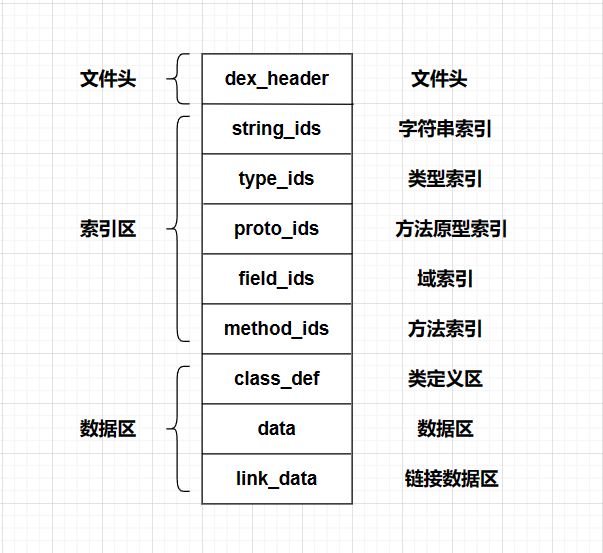
dex文件结构体的定义在Android源码目录/dalvik/libdex/DexFile.h中可以找到,其中定义的dex文件结构体如下:
1
2
3
4
5
6
7
8
9
10
11
12
13
14
15
16
17
18
19
20
21
22
23
24
25
26
27
28
29
30
|
struct DexFile {
/* directly-mapped "opt" header */
const DexOptHeader* pOptHeader;
/* pointers to directly-mapped structs and arrays in base DEX */
const DexHeader* pHeader;
const DexStringId* pStringIds;
const DexTypeId* pTypeIds;
const DexFieldId* pFieldIds;
const DexMethodId* pMethodIds;
const DexProtoId* pProtoIds;
const DexClassDef* pClassDefs;
const DexLink* pLinkData;
/*
* These are mapped out of the "auxillary" section, and may not be
* included in the file.
*/
const DexClassLookup* pClassLookup;
const void* pRegisterMapPool; // RegisterMapClassPool
/* points to start of DEX file data */
const u1* baseAddr;
/* track memory overhead for auxillary structures */
int overhead;
/* additional app-specific data structures associated with the DEX */
//void* auxData;
};
|
为方便使用仅保留部分字段,编写相关函数如下
通过字节buffer或文件路径创建DexFile类并初始化各个字段
1
2
3
4
5
6
7
8
9
10
11
12
13
14
15
16
17
18
19
20
21
22
23
24
25
26
27
28
29
30
31
32
33
34
35
36
37
|
class DexFile {
u1* baseAddr{nullptr};
DexHeader* pHeader{nullptr};
DexStringId* pStringIds{nullptr};
DexTypeId* pTypeIds{nullptr};
DexFieldId* pFieldIds{nullptr};
DexMethodId* pMethodIds{nullptr};
DexProtoId* pProtoIds{nullptr};
DexClassDef* pClassDefs{nullptr};
void initFields(unsigned char *buffer);
}
// Init functions
void DexFile::initFields(unsigned char* buffer) {
if(buffer==nullptr) {
printf("Null pointer provided!\n");
exit(0);
}
baseAddr=buffer;
pHeader=(DexHeader*)baseAddr;
pStringIds=(DexStringId*)(baseAddr+pHeader->stringIdsOff);
pTypeIds=(DexTypeId*)(baseAddr+pHeader->typeIdsOff);
pFieldIds=(DexFieldId*)(baseAddr+pHeader->fieldIdsOff);
pMethodIds=(DexMethodId*)(baseAddr+pHeader->methodIdsOff);
pProtoIds=(DexProtoId*)(baseAddr+pHeader->protoIdsOff);
pClassDefs=(DexClassDef*)(baseAddr+pHeader->classDefsOff);
}
DexFile::DexFile(unsigned char *buffer) {
initFields(buffer);
}
DexFile::DexFile(std::string filePath) {
size_t fileLength=0;
initFields(readFileToBytes(filePath, fileLength));
}
DexFile::~DexFile() {
delete baseAddr;
}
|
DexHeader定义如下
1
2
3
4
5
6
7
8
9
10
11
12
13
14
15
16
17
18
19
20
21
22
23
24
25
|
typedef struct DexHeader {
u1 magic[8]; //Dex版本号 dex.035 .035即为版本号
u4 checksum; //adler32检验,如果修改了Dex文件,需要修正这个值,否则会运行不起来
u1 signature[kSHA1DigestLen]; //SHA-1值,Android不检测该值,但如果修改了Dex文件,最好修复该值,再修checksum
u4 fileSize; //整个dex文件的大小
u4 headerSize; //DexHeader结构的大小,固定为0x70
u4 endianTag; //字节序标记,若该字段按小端方式读出来为0x12345678,则整个Dex文件就是小端方式.如果按大端方式读出来为0x12345678,那整个Dex文件就是大端方式
u4 linkSize; //链接段大小
u4 linkOff; //链接段偏移
u4 mapOff; //DexMapList文件偏移
u4 stringIdsSize; //DexStringId个数
u4 stringIdsOff; //DexStringId文件偏移
u4 typeIdsSize; //DexTypeId个数
u4 typeIdsOff; //DexTypeId文件偏移
u4 protoIdsSize; //DexProtoId个数
u4 protoIdsOff; //DexProtoId文件偏移
u4 fieldIdsSize; //DexFieldId个数
u4 fieldIdsOff; //DexFieldId文件偏移
u4 methodIdsSize; //DexMethodId个数
u4 methodIdsOff; //DexMethodId文件偏移
u4 classDefsSize; //DexClassDef个数
u4 classDefsOff; //DexClassDef文件偏移
u4 dataSize; //数据段大小
u4 dataOff; //数据段文件偏移
} DexHeader;
|
打印DexHeader
1
2
3
4
5
6
7
8
9
10
11
12
13
14
15
16
17
18
19
20
21
22
23
24
25
26
27
|
void DexFile::printDexHeader() {
printf("DexHeader:\n");
printf("\tmagic: ");printHexBytes(pHeader->magic,sizeof(pHeader->magic));printf("\n");
printf("\tchecksum: %#x\n",pHeader->checksum);
printf("\tsignature: ");printHexBytes(pHeader->signature,kSHA1DigestLen);printf("\n");
printf("\tFileSize: %#x\n",pHeader->fileSize);
printf("\tHeaderSize: %#x\n",pHeader->headerSize);
printf("\tEndianTag: %#x\n",pHeader->endianTag);
printf("\tLinkOff: %#x\n",pHeader->linkOff);
printf("\tLinkSize: %#x\n",pHeader->linkSize);
printf("\tMapOff: %#x\n",pHeader->mapOff);
printf("\tStringIDs Offset: %#x\n",pHeader->stringIdsOff);
printf("\tNum of StringIDs: %#x\n",pHeader->stringIdsSize);
printf("\tTypeIDs Offset: %#x\n",pHeader->typeIdsOff);
printf("\tNum of TypeIDs: %#x\n",pHeader->typeIdsSize);
printf("\tProtoIDs Offset: %#x\n",pHeader->protoIdsOff);
printf("\tNum of ProtoIDs: %#x\n",pHeader->protoIdsSize);
printf("\tFieldIDs Offset: %#x\n",pHeader->fieldIdsOff);
printf("\tNum of FieldIDs: %#x\n",pHeader->fieldIdsSize);
printf("\tMethodIDs Offset: %#x\n",pHeader->methodIdsOff);
printf("\tNum of MethodIDs: %#x\n",pHeader->methodIdsSize);
printf("\tClassDefs Offset: %#x\n",pHeader->classDefsOff);
printf("\tNum of ClassDefs: %#x\n",pHeader->classDefsSize);
printf("\tData Offset: %#x\n",pHeader->dataOff);
printf("\tSize of Data: %#x\n",pHeader->dataSize);
printf("DexHeader End\n");
}
|
效果如下
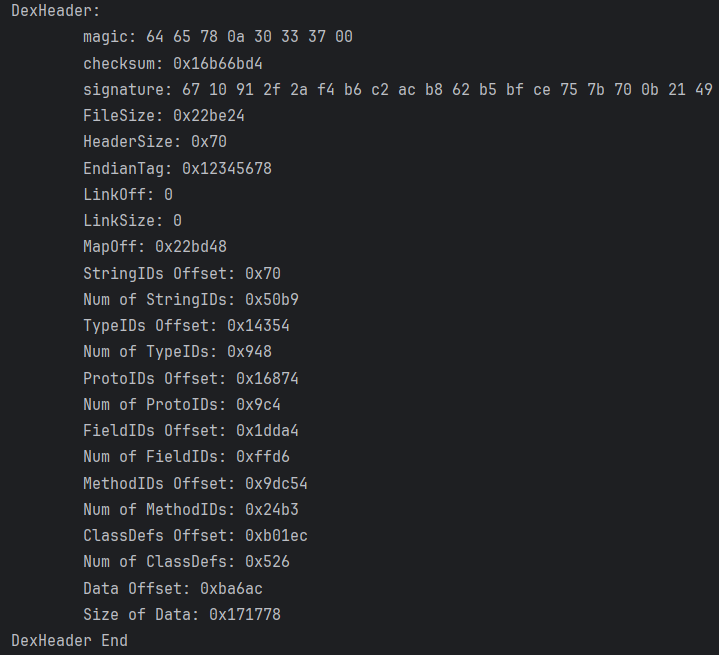
Dex String ID
定义如下
1
2
3
4
5
6
7
8
9
|
struct DexStringId {
u4 stringDataOff; /* 字符串的文件偏移量 */
};
//伪结构表示如下:
struct string_data_item {
uleb128 utf16_size; //字符串长度
ubyte[] data; //字符串数据
}
|
注意dex文件的字符串采用MUTF-8编码,与UTF-8区别如下:
- MUTF-8使用1~3字节编码
- 大于16位的Unicode编码U+10000~U+10ffff使用3字节编码
- U+000采用2字节编码
- 以0x00空字符作为字符串结尾
MUTF-8字符串头部保存的是字符串长度,是uleb128类型

相关函数定义如下,解析StringId
1
2
3
4
5
6
7
8
9
10
11
12
13
14
15
16
17
18
19
20
21
22
23
24
25
26
27
28
29
|
// StringId functions
// 通过索引获取对应StringId
DexStringId DexFile::getStringIdByIndex(u4 index) {
if(checkIndexIsLegal(index,pHeader->stringIdsSize-1)) {
return pStringIds[index];
}
printf("No such index: %x\n",index);
exit(0);
}
// 解析StringId 获取字符串长度
size_t DexFile::getStringDataLength(DexStringId& stringId) {
const u1* ptr = baseAddr + stringId.stringDataOff;
size_t size=0;
myReadUnsignedLeb128(ptr,&size);
return size;
}
// 解析StringId 获取字符串
std::string DexFile::getStringIdData(const DexStringId& stringId) {
const u1* ptr = baseAddr + stringId.stringDataOff;
while (*(ptr++) > 0x7f);// Skip the uleb128 length.
return (char*)ptr;
}
// 通过索引获取StringId的字符串
std::string DexFile::getStringIdDataByIndex(u4 index) {
if(checkIndexIsLegal(index,pHeader->stringIdsSize-1)) {
return getStringIdData(pStringIds[index]);
}
return nullptr;
}
|
打印所有StringId,没有做MUTF编码处理,直接打印ASCII字符串
1
2
3
4
5
6
7
8
|
void DexFile::printStringIds() {
printf("StringIds:\n");
printf("\tNums\t\tStrings\n");
for(int i=0;i<pHeader->stringIdsSize;i++) {
printf("\t%08x\t%s\n",i,getStringIdDataByIndex(i).c_str());
}
printf("StringIds End\n");
}
|
效果如下,没有做编码处理故可能出现乱码
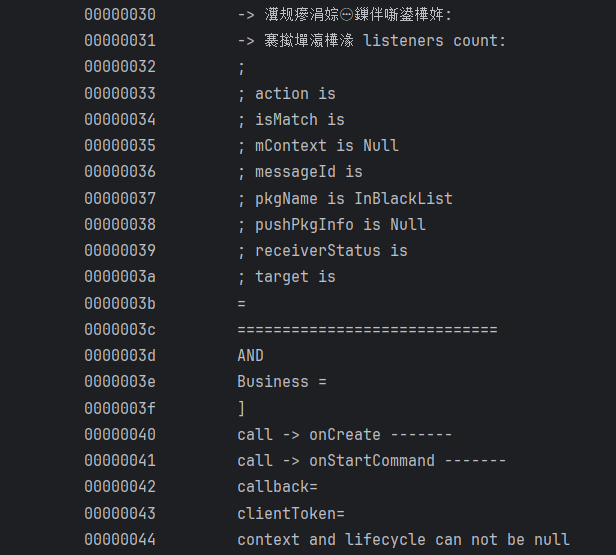
Dex Type ID
定义如下
1
2
3
|
typedef struct DexTypeId {
u4 descriptorIdx; //指向DexStringId列表的索引
} DexTypeId;
|
descriptorIdx为DexStringID表的索引,对应字符串表示类的类型
例如此处DexTypeID[3].descriptorIdx=6, 而DexStringID[6]对应的字符串为"Ljava/lang/String;"
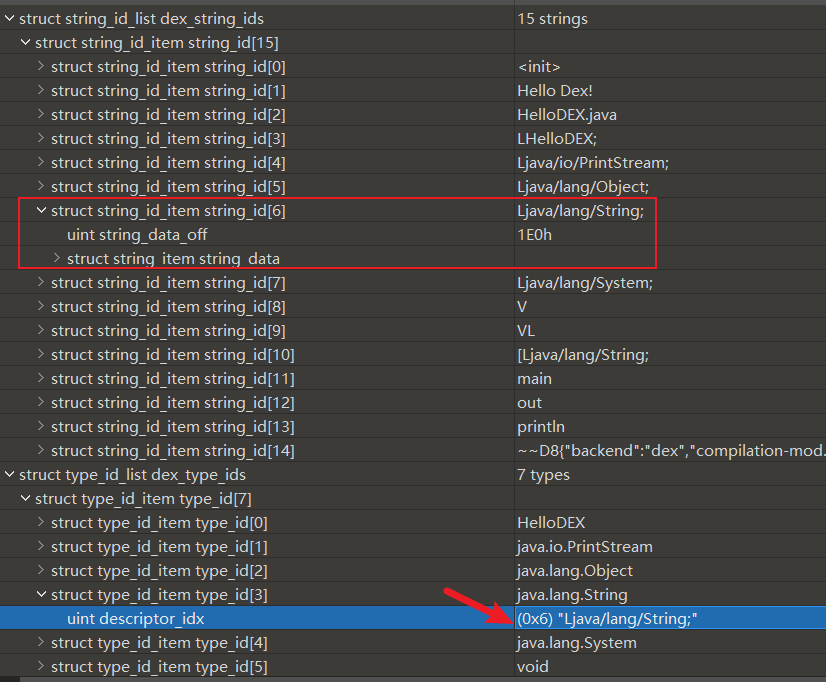
和StringId类似,TypeId的解析代码如下,通过索引获取StringId及其对应的字符串
1
2
3
4
5
6
7
8
9
10
11
12
13
14
15
16
|
// TypeId functions
// 通过索引获取对应TypeId
DexTypeId DexFile::getTypeIdByIndex(u4 index) {
if(checkIndexIsLegal(index,pHeader->typeIdsSize-1)) {
return pTypeIds[index];
}
printf("No such index: %x\n",index);
exit(0);
}
// 通过索引获取TypeId对应的字符串
std::string DexFile::getTypeIdDataByIndex(u4 index) {
if(checkIndexIsLegal(index,pHeader->typeIdsSize-1)) {
return getStringIdDataByIndex(pTypeIds[index].descriptorIdx);
}
return nullptr;
}
|
打印所有TypeId
1
2
3
4
5
6
7
8
|
void DexFile::printTypeIds() {
printf("TypeIds:\n");
printf("\tNums\t\tTypeIds\n");
for(int i=0;i<pHeader->typeIdsSize;i++) {
printf("\t%08x\t%s\n",i,getTypeIdDataByIndex(i).c_str());
}
printf("TypeIds End\n");
}
|
效果如下
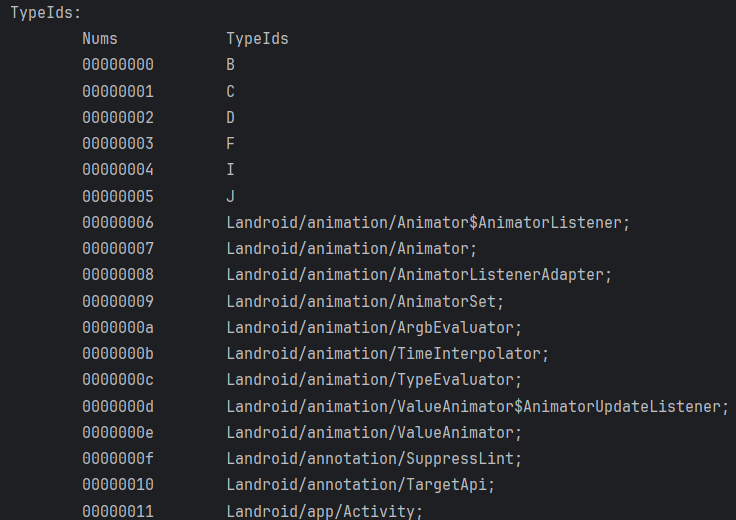
Dex Proto ID
DexProtoId是**方法声明(方法签名)**的结构体,保存方法(函数)的返回值类型和参数类型列表,没有函数名,定义如下
1
2
3
4
5
|
typedef struct DexProtoId {
u4 shortyIdx; //方法声明字符串,指向DexStringId列表的索引
u4 returnTypeIdx; //方法返回类型字符串,指向DexTypeId列表的索引
u4 parametersOff; //方法的参数列表,指向DexTypeList列表的索引
} DexProtoId;
|
parametersOff是DexTypeList的文件偏移
DexTypeList
结构定义如下
1
2
3
4
5
6
7
8
|
typedef struct DexTypeList {
u4 size; //DexTypeItem个数, 即参数个数
DexTypeItem list[size]; //DexTypeItem数组, 按从左到右的顺序保存了方法的参数
} DexTypeList;
typedef struct DexTypeItem {
u2 typeIdx; //指向DexTypeId列表的索引
} DexTypeItem;
|
例如此处DexProtoID[1]
方法声明 DexStringID[shortyIdx]=“VL”
返回类型 DexStringID[DexTypeID[returnTypeIdx]]=“V”
参数列表 DexStringID[DexTypeID[typeIdx]]=“Ljava/lang/String;”
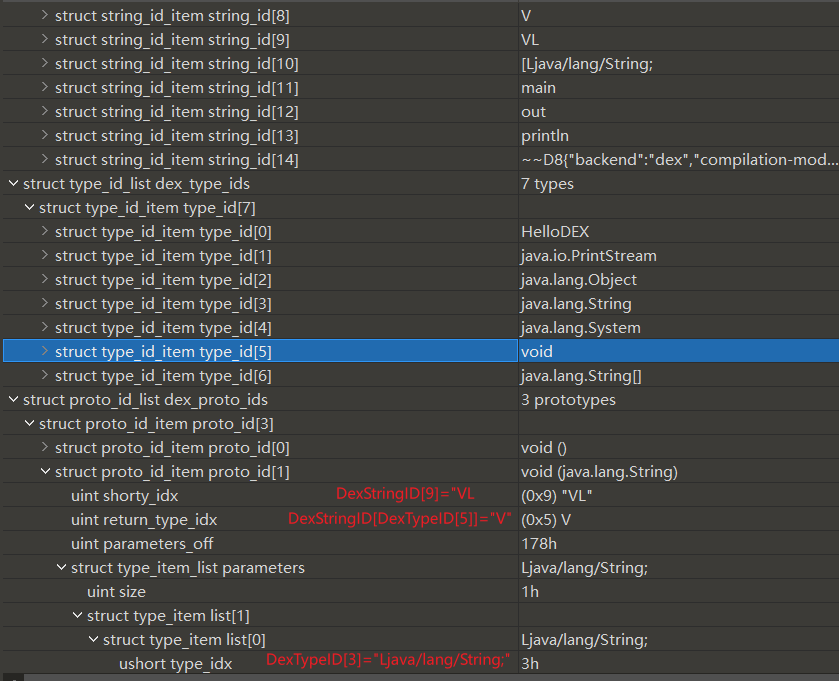
解析代码如下
1
2
3
4
5
6
7
8
9
10
11
12
13
14
15
16
17
18
19
20
21
22
23
24
25
26
27
28
29
30
31
32
33
34
35
36
37
38
39
40
41
42
43
44
45
46
47
48
49
50
51
|
// ProtoId functions
const DexProtoId DexFile::getProtoIdByIndex(u4 index) {
if(checkIndexIsLegal(index,pHeader->protoIdsSize-1)) {
return pProtoIds[index];
}
illegalIndex(index);
}
std::string DexFile::getProtoIdShorty(const DexProtoId& protoId) {
return getStringIdDataByIndex(protoId.shortyIdx);
}
std::string DexFile::getProtoIdReturnType(const DexProtoId& protoId) {
return getTypeIdDataByIndex(protoId.returnTypeIdx);
}
// 获取ProtoId的参数列表,解析TypeList结构
std::vector<std::string> DexFile::getProtoIdParameters(const DexProtoId& protoId) {
std::vector<std::string> parameters;
//无参数
if(protoId.parametersOff==0) {
return parameters;
}
//解析TypeList结构 获取参数列表
DexTypeList* typeList=(DexTypeList*)(baseAddr+protoId.parametersOff);
for(int i=0;i<typeList->size;i++) {
parameters.push_back(getTypeIdDataByIndex(typeList->list[i].typeIdx));
}
return parameters;
}
// 解析DexProtoId结构体 返回解析后的字符串
std::string DexFile::parseProtoId(const DexProtoId& protoId) {
std::string shorty=getProtoIdShorty(protoId);//c++的string类型会自动遍历const char*字符串并复制
std::string return_type = getProtoIdReturnType(protoId);
std::vector<std::string> parameters=getProtoIdParameters(protoId);
std::string result;
result+=parseString(return_type)+" (";
//解析参数
for(int i=0;i<parameters.size();i++) {
result+=parseString(parameters[i]);
if(i!=parameters.size()-1)//多个参数以,分隔
result+=",";
}
result+=")";
return result;
}
// 通过索引解析ProtoId,返回解析后的对应字符串
std::string DexFile::getProtoIdDataByIndex(u4 index) {
if(checkIndexIsLegal(index,pHeader->protoIdsSize-1)) {
return parseProtoId(getProtoIdByIndex(index));
}
return nullptr;
}
|
打印所有ProtoId
1
2
3
4
5
6
7
8
|
void DexFile::printProtoIds() {
printf("ProtoIds:\n");
printf("\tNums\t\tProtoIds\n");
for(int i=0;i<pHeader->protoIdsSize;i++) {
printf("\t%08x\t%s\n",i,getProtoIdDataByIndex(i).c_str());
}
printf("ProtoIds End\n");
}
|
效果如下
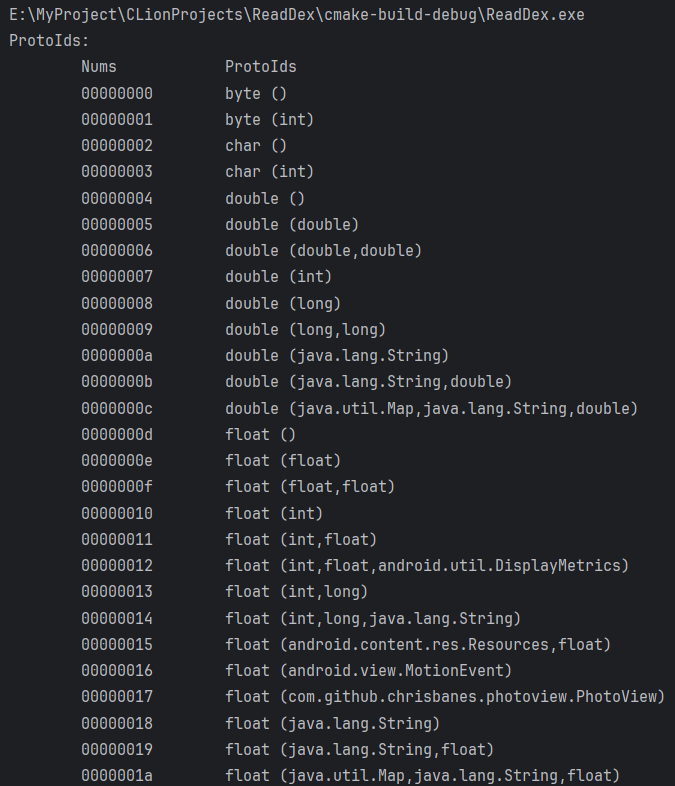
Dex Field ID
DexFieldID结构体指明了成员变量所在的类,类型以及变量名
1
2
3
4
5
|
typedef struct DexFieldId {
u2 classIdx; //类的类型,指向DexTypeId列表的索引
u2 typeIdx; //字段类型,指向DexTypeId列表的索引
u4 nameIdx; //字段名,指向DexStringId列表的索引
} DexFieldId;
|
寻找方法类似,out是java.lang.System类的成员,类型为java.io.PrintStream
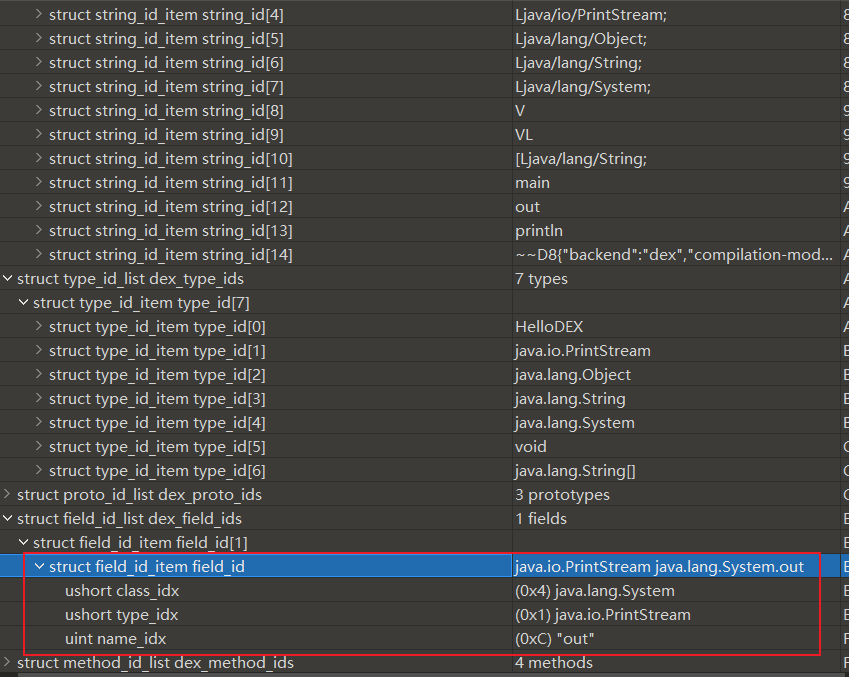
解析代码如下
1
2
3
4
5
6
7
8
9
10
11
12
13
14
15
16
17
18
19
20
21
22
23
24
25
26
27
28
29
30
31
32
33
|
// FieldId functions
const DexFieldId DexFile::getFieldIdByIndex(u4 index) {
if(checkIndexIsLegal(index,pHeader->fieldIdsSize-1)) {
return pFieldIds[index];
}
illegalIndex(index);
}
// 获取FieldId所在类类名
std::string DexFile::getFieldIdClass(const DexFieldId& fieldId) {
return getTypeIdDataByIndex(fieldId.classIdx);
}
// 获取FieldId类型
std::string DexFile::getFieldIdType(const DexFieldId& fieldId) {
return getTypeIdDataByIndex(fieldId.typeIdx);
}
// 获取FieldId名称
std::string DexFile::getFieldIdName(const DexFieldId& fieldId) {
return getStringIdDataByIndex(fieldId.nameIdx);
}
// 解析DexFieldId结构,字段所在类,类型,名称
std::string DexFile::parseFieldId(const DexFieldId& fieldId) {
std::string fieldClass=getFieldIdClass(fieldId);
std::string fieldType=getFieldIdType(fieldId);
std::string fieldName=getFieldIdName(fieldId);
return parseString(fieldType)+" "+parseString(fieldClass)+"."+fieldName;
}
// 通过索引获取FieldId对应的字符串
std::string DexFile::getFieldIdDataByIndex(u4 index) {
if(checkIndexIsLegal(index,pHeader->fieldIdsSize-1)) {
return parseFieldId(getFieldIdByIndex(index));
}
return nullptr;
}
|
打印所有ProtoId
1
2
3
4
5
6
7
8
|
void DexFile::printFieldIds() {
printf("FieldIds:\n");
printf("\tNums\t\tFieldIds\n");
for(int i=0;i<pHeader->fieldIdsSize;i++) {
printf("\t%08x\t%s\n",i,getFieldIdDataByIndex(i).c_str());
}
printf("FieldId End\n");
}
|
效果如下
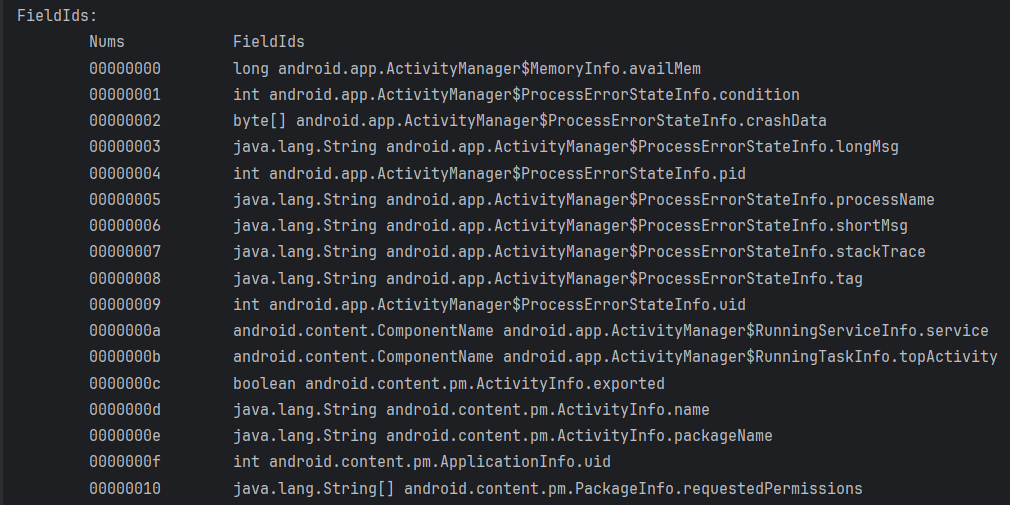
Dex Method ID
DexMethodId结构体指明了方法所在的类、方法声明(签名)以及方法名, 即完整的方法声明
1
2
3
4
5
|
struct DexMethodId {
u2 classIdx; /* 方法的所属的类,指向DexTypeId列表的索引 */
u2 protoIdx; /* 声明类型,指向DexProtoId列表的索引 */
u4 nameIdx; /* 方法名,指向DexStringId列表的索引 */
};
|
寻找方法
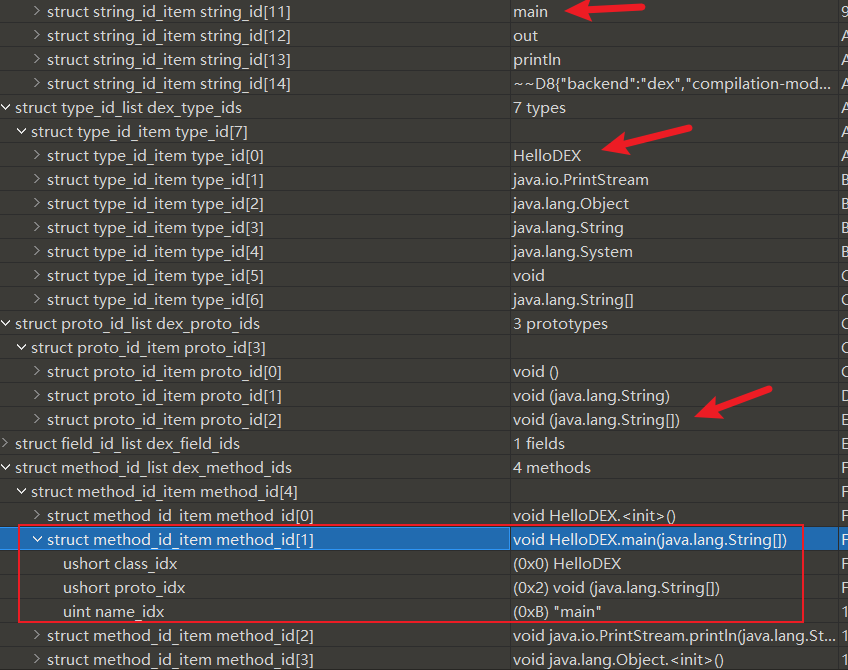
对应解析代码如下
1
2
3
4
5
6
7
8
9
10
11
12
13
14
15
16
17
18
19
20
21
22
23
24
25
26
27
28
29
30
31
32
33
34
|
// MethodId functions
const DexMethodId DexFile::getMethodIdByIndex(u4 index) {
if(checkIndexIsLegal(index,pHeader->methodIdsSize-1)) {
return pMethodIds[index];
}
illegalIndex(index);
}
// 获取MethodId所在类名
std::string DexFile::getMethodIdClass(const DexMethodId& methodId) {
return getTypeIdDataByIndex(methodId.classIdx);
}
// 获取MethodId对应方法签名
std::string DexFile::getMethodIdProto(const DexMethodId& methodId) {
return getProtoIdDataByIndex(methodId.protoIdx);
}
// 获取MethodId对应方法名
std::string DexFile::getMethodIdName(const DexMethodId& methodId) {
return getStringIdDataByIndex(methodId.nameIdx);
}
// 解析DexMethodId结构
std::string DexFile::parseMethodId(const DexMethodId& methodId) {
std::string methodProto=getMethodIdProto(methodId);
//解析class并拼接name
std::string methodFullName=parseString(getMethodIdClass(methodId))+getMethodIdName(methodId);
//拼接proto和class.name
return methodProto.insert(methodProto.find(' ')+1,methodFullName);
}
// 通过索引获取MethodId对应字符串
std::string DexFile::getMethodIdDataByIndex(u4 index) {
if(checkIndexIsLegal(index,pHeader->methodIdsSize-1)) {
return parseMethodId(getMethodIdByIndex(index));
}
return nullptr;
}
|
打印所有MethodId
1
2
3
4
5
6
7
8
|
void DexFile::printMethodIds() {
printf("MethodIds:\n");
printf("\tNums\t\tMethodIds\n");
for(int i=0;i<pHeader->methodIdsSize;i++) {
printf("\t%08x\t%s\n",i,getMethodIdDataByIndex(i).c_str());
}
printf("MethodIds End\n");
}
|
效果如下
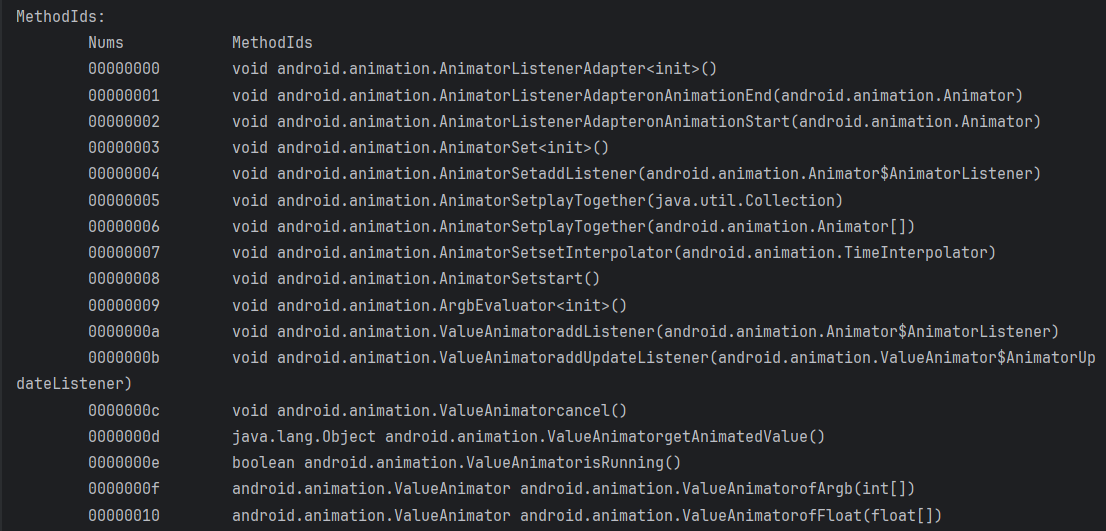
Dex Map List
Dalvik虚拟机解析dex文件后,映射为DexMapList的数据结构, 该结构由DexHeader.mapOff指明位置
1
2
3
4
5
6
7
8
9
10
11
|
struct DexMapList {
u4 size; /* DexMapItem个数 */
DexMapItem list[1]; /* DexMapItem数组 */
};
struct DexMapItem {
u2 type; /* KDexType开头的类型 */
u2 unused; /* 未使用,用于字节对齐 */
u4 size; /* 类型的个数 */
u4 offset; /* 类型数据的文件偏移 */
};
|
type是枚举常量,用于判断类型
1
2
3
4
5
6
7
8
9
10
11
12
13
14
15
16
17
18
19
20
21
22
23
|
/* map item type codes */
enum {
kDexTypeHeaderItem = 0x0000,
kDexTypeStringIdItem = 0x0001,
kDexTypeTypeIdItem = 0x0002,
kDexTypeProtoIdItem = 0x0003,
kDexTypeFieldIdItem = 0x0004,
kDexTypeMethodIdItem = 0x0005,
kDexTypeClassDefItem = 0x0006,
kDexTypeCallSiteIdItem = 0x0007,
kDexTypeMethodHandleItem = 0x0008,
kDexTypeMapList = 0x1000,
kDexTypeTypeList = 0x1001,
kDexTypeAnnotationSetRefList = 0x1002,
kDexTypeAnnotationSetItem = 0x1003,
kDexTypeClassDataItem = 0x2000,
kDexTypeCodeItem = 0x2001,
kDexTypeStringDataItem = 0x2002,
kDexTypeDebugInfoItem = 0x2003,
kDexTypeAnnotationItem = 0x2004,
kDexTypeEncodedArrayItem = 0x2005,
kDexTypeAnnotationsDirectoryItem = 0x2006,
};
|
size指定了类型个数,在dex文件中连续存放, offset是起始地址文件偏移
例如DexMapList[1] type=string_id_item, size=0xF, offset=0x70
和DexStringID表正好对应,起始地址,表项数
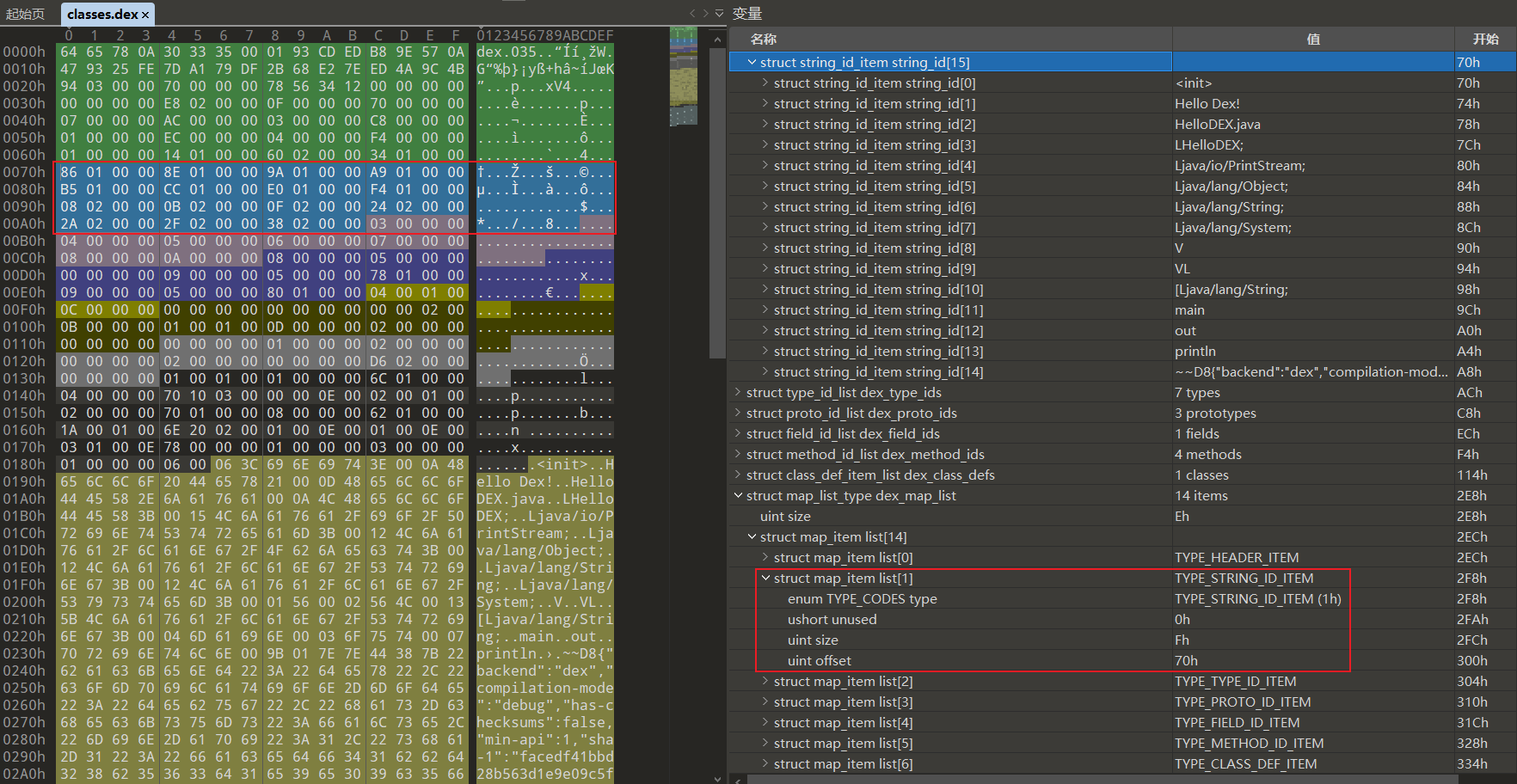
解析代码如下
1
2
3
4
5
6
7
8
9
10
11
12
13
14
15
16
17
18
19
20
21
22
23
24
25
26
27
28
29
30
31
32
33
34
35
36
37
|
void DexFile::printMapList() {
static std::map<int, std::string> MapItemTypeToStringMap = {
{kDexTypeHeaderItem, "HeaderItem"},
{kDexTypeStringIdItem, "StringIdItem"},
{kDexTypeTypeIdItem, "TypeIdItem"},
{kDexTypeProtoIdItem, "ProtoIdItem"},
{kDexTypeFieldIdItem, "FieldIdItem"},
{kDexTypeMethodIdItem, "MethodIdItem"},
{kDexTypeClassDefItem, "ClassDefItem"},
{kDexTypeMapList, "MapList"},
{kDexTypeTypeList, "TypeList"},
{kDexTypeAnnotationSetRefList, "AnnotationSetRefList"},
{kDexTypeAnnotationSetItem, "AnnotationSetItem"},
{kDexTypeClassDataItem, "ClassDataItem"},
{kDexTypeCodeItem, "CodeItem"},
{kDexTypeStringDataItem, "StringDataItem"},
{kDexTypeDebugInfoItem, "DebugInfoItem"},
{kDexTypeAnnotationItem, "AnnotationItem"},
{kDexTypeEncodedArrayItem, "EncodedArrayItem"},
{kDexTypeAnnotationsDirectoryItem, "AnnotationsDirectoryItem"}
};
DexMapList* pMapList=(DexMapList*)(baseAddr+pHeader->mapOff);
DexMapItem* pMapItems=pMapList->list;
printf("MapList has %d items, start at: %#x\n",pMapList->size,pHeader->mapOff);
printf("Nums\t\tType\t\t\t\tItemNums\tStartOff\n");
for(int i=0;i<pMapList->size;i++) {
// 解析MapType
auto it=MapItemTypeToStringMap.find(pMapItems[i].type);
std::string mapType;
if(it!= MapItemTypeToStringMap.end())
mapType=it->second;
else mapType="Unknown Type";
printf("%08d\t%-24s\t%08d\t%08x\n",i+1,mapType.c_str(),pMapItems[i].size,pMapItems[i].offset);
}
printf("MapList End\n");
}
|
打印效果如下
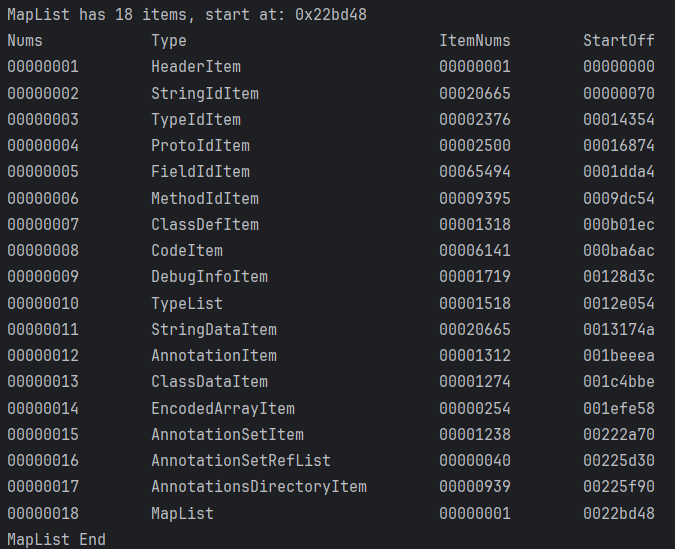
Dex Class Def
该结构较为复杂(这部分相关代码比前文所有结构代码之和都大)
有了对Dex文件的基本了解和上面各个结构的基础,才能解析该结构
DexClassDef保存了类的相关信息,定义如下
1
2
3
4
5
6
7
8
9
10
|
struct DexClassDef {
u4 classIdx; /* 类的类型(即全限定类名),指向DexTypeId列表的索引 */
u4 accessFlags; /* 访问标志,以ACC_开头的枚举值,如ACC_PUBLIC(0x1)、ACC_PRIVATE(0x2)*/
u4 superclassIdx; /* 父类类型,指向DexTypeId列表的索引*/
u4 interfacesOff; /* 接口,指向DexTypeList的文件偏移,如果类中不含有接口声明和实现,则值为0 */
u4 sourceFileIdx; /* 类所在源文件的文件名,指向DexStringId列表的索引 */
u4 annotationsOff; /* 注解,指向DexAnnotationsDirectoryItem结构体,根据类型不同会有注解类、注解方法、注解字段与注解参数,如果类中没有注解,则值为0 */
u4 classDataOff; /* 指向DexClassData结构的文件偏移,DexClassData结构是类的数据部分 */
u4 staticValuesOff; /* 指向DexEncodedArray结构的文件偏移,记录类中的静态数据, 没有则为0 */
};
|
解析代码如下
将ClassDef结构划分为4部分解析: BasicInfo, Annotations, ClassData, StaticValues, 从classIdx到sourceFileIx属于BasicInfo
每部分使用单独的打印函数进行处理
1
2
3
4
5
6
7
8
9
10
11
12
13
14
15
16
17
18
19
20
21
22
23
24
25
26
27
28
29
30
31
32
33
|
// 打印所有ClassDef信息
void DexFile::printClassDefs() {
printf("ClassDefs:\n");
for(int i=0;i<pHeader->classDefsSize;i++) {
DexClassDef classDef=pClassDefs[i];
// 1.Basic info
printf("=========================ClassDef %08d=========================\n",i+1);
printClassDefBasicInfo(classDef);
// 2. Annotations
if(classDef.annotationsOff) {
printf("Annotations:\n");
printClassDefAnnotations(*(DexAnnotationsDirectoryItem*)(baseAddr+classDef.annotationsOff));
// 值传递只保留前16字节导致内存访问错,需要引用传递
// DexAnnotationsDirectoryItem annotations_directory_item=*(DexAnnotationsDirectoryItem*)(baseAddr+classDef.annotationsOff);
// parseClassDefAnnotations(annotations_directory_item);
}
else
printf("No Annotations\n");
// 3. ClassData
if(classDef.classDataOff) {
printClassDefClassData(*(DexClassData*)(baseAddr+classDef.classDataOff));
}else
printf("No ClassData\n");
// 4. StaticValues
if(classDef.staticValuesOff) {
printClassDefStaticValues(*(DexEncodedArray*)(baseAddr+classDef.staticValuesOff));
}else
printf("No StaticValues\n");
printf("===================================================================\n");
}
printf("ClassDefs End\n");
}
|
ClassDefBasicInfo
代码如下
1
2
3
4
5
6
7
8
9
10
11
12
13
14
15
16
17
18
19
20
21
22
23
24
25
26
27
28
29
30
31
32
33
34
35
36
37
38
39
40
41
42
43
44
45
46
47
48
49
50
51
52
53
54
55
56
57
58
59
60
61
62
63
64
65
66
67
68
69
70
71
72
73
74
75
76
77
78
79
80
81
82
83
|
// ClassDef Basic Info functions
// 获取class
std::string DexFile::getClassDefClass(DexClassDef& classDef) {
return parseString(getTypeIdDataByIndex(classDef.classIdx));
}
// 解析权限修饰符
std::string DexFile::parseAccessFlags(u4 accessFlags) {
static std::map<int, std::string> AccessFlagMap = {
{ACC_PUBLIC, "public"},
{ACC_PRIVATE, "private"},
{ACC_PROTECTED, "protected"},
{ACC_STATIC, "static"},
{ACC_FINAL, "final"},
{ACC_SYNCHRONIZED, "synchronized"},
{ACC_SUPER, "super"},
{ACC_VOLATILE, "volatile"},
{ACC_BRIDGE, "bridge"},
{ACC_TRANSIENT, "transient"},
{ACC_VARARGS, "varargs"},
{ACC_NATIVE, "native"},
{ACC_INTERFACE, "interface"},
{ACC_ABSTRACT, "abstract"},
{ACC_STRICT, "strict"},
{ACC_SYNTHETIC, "synthetic"},
{ACC_ANNOTATION, "annotation"},
{ACC_ENUM, "enum"},
{ACC_CONSTRUCTOR, "constructor"},
{ACC_DECLARED_SYNCHRONIZED, "declared_synchronized"}
};
std::string result;
for(int i=0;i<32;i++) {
if(accessFlags & (1 << i)) {
result+=AccessFlagMap[1 << i]+" ";//遍历添加权限控制属性
}
}
if(!result.empty())
result=result.substr(0,result.length()-1);//去除末尾多余空格
return result;
}
// 获取父类
std::string DexFile::getClassDefSuperClass(DexClassDef& classDef) {
return parseString(getTypeIdDataByIndex(classDef.superclassIdx));
}
// 获取接口列表
std::vector<std::string> DexFile::getClassDefInterfaces(DexClassDef& classDef) {
std::vector<std::string> interfaces;
//无参数
if(classDef.interfacesOff==0) {
return interfaces;
}
DexTypeList* typeList=(DexTypeList*)(baseAddr+classDef.interfacesOff);
for(int i=0;i<typeList->size;i++) {
interfaces.push_back(getTypeIdDataByIndex(typeList->list[i].typeIdx));
}
return interfaces;
}
// 获取源文件
std::string DexFile::getClassDefSourceFile(DexClassDef& classDef) {
return getStringIdDataByIndex(classDef.sourceFileIdx);
}
// 打印ClassDef结构的基本信息: 类名 父类 源文件名 接口
void DexFile::printClassDefBasicInfo(DexClassDef& classDef) {
std::string className=getClassDefClass(classDef);
std::string accessFlags=parseAccessFlags(classDef.accessFlags);
std::string superClass=getClassDefSuperClass(classDef);
std::vector<std::string> interfaces=getClassDefInterfaces(classDef);
std::string sourceFile=getClassDefSourceFile(classDef);
// Basic info, class super_class source_file interfaces
printf("Class:\t\t%s\n",combineAccFlagsAndName(accessFlags,className).c_str());
printf("Super Class:\t%s\n",superClass.c_str());
printf("Source File:\t%s\n",sourceFile.c_str());
// print interfaces if have it
if(!interfaces.empty()) {
printf("Interfaces:\nNums\t\tInterface\n");
for(int j=0;j<interfaces.size();j++) {
printf("%08d\t%s\n",j+1,parseString(interfaces[j]).c_str());
}
}else {
printf("No Interfaces\n");
}
}
|
效果如下

DexAnnotationsDirectoryItem
annotationsOff指向该结构,用于指向类的所有注解,定义如下
1
2
3
4
5
6
7
8
9
10
|
struct DexAnnotationsDirectoryItem {
u4 classAnnotationsOff; /* 类注解,值为DexAnnotationSetItem的文件偏移量, 为0表示不存在*/
u4 fieldsSize; /* 域注解,值为DexFieldAnnotationsItem的数量 */
u4 methodsSize; /* 方法注解,值为DexMethodAnnotationsItem的数量 */
u4 parametersSize; /* 参数注解。值为DexParameterAnnotationsItem的数量 */
/* 后3结构中存在1个或多个,则在后面追加以下数据,并按顺序排列 */
/* followed by DexFieldAnnotationsItem[fieldsSize] */
/* followed by DexMethodAnnotationsItem[methodsSize] */
/* followed by DexParameterAnnotationsItem[parametersSize] */
};
|
printClassDefAnnotations函数用于打印该结构,根据不同注解类型调用不同函数解析
1
2
3
4
5
6
7
8
9
10
11
12
13
14
15
16
17
18
19
20
21
22
23
24
25
26
27
28
29
30
31
32
33
34
35
36
37
38
39
40
|
// 打印ClassDef的所有Annotations
void DexFile::printClassDefAnnotations(DexAnnotationsDirectoryItem& annotationsDirectory) {
//1. 类注解
if(annotationsDirectory.classAnnotationsOff)
printClassAnnotations(*(DexAnnotationSetItem*)(baseAddr+annotationsDirectory.classAnnotationsOff));
else
printf("No Class Annotations\n\n");
//2. 域(字段)注解
if(annotationsDirectory.fieldsSize) {
printFieldAnnotations(
(DexFieldAnnotationsItem*)((uintptr_t)&annotationsDirectory
+sizeof(DexAnnotationsDirectoryItem))
,annotationsDirectory.fieldsSize);
}else
printf("No Field Annotations\n\n");
//3. 方法注解
if(annotationsDirectory.methodsSize) {
printMethodAnnotations(
(DexMethodAnnotationsItem*)
((uintptr_t)&annotationsDirectory
+sizeof(DexAnnotationsDirectoryItem)
+sizeof(DexFieldAnnotationsItem)*annotationsDirectory.fieldsSize)
,annotationsDirectory.methodsSize);
}else {
printf("No Method Annotations\n\n");
}
//4. 参数注解
if(annotationsDirectory.parametersSize) {
printParameterAnnotations(
(DexParameterAnnotationsItem*)((uintptr_t)&annotationsDirectory
+sizeof(DexAnnotationsDirectoryItem)
+sizeof(DexFieldAnnotationsItem)*annotationsDirectory.fieldsSize
+sizeof(DexMethodAnnotationsItem)*annotationsDirectory.methodsSize)
,annotationsDirectory.parametersSize);
}else {
printf("No Parameter Annotations\n\n");
}
}
|
类注解 DexAnnotationSetItem
1
2
3
4
5
6
7
8
9
|
struct DexAnnotationSetItem {
u4 size; /* DexAnnotationItem的数量 */
u4 entries[1]; /* entries数组,存储DexAnnotationItem的文件偏移量 */
};
struct DexAnnotationItem {
u1 visibility; /* 此注释的预期可见性 */
u1 annotation[1]; /* encoded_annotation格式的注释内容 */
};
|
visibility表示注释的可见性,主要有以下几种情况:
| 名称 |
值 |
说明 |
| VISIBILITY_BUILD |
0x00 |
预计仅在构建(例如,在编译其他代码期间)时可见 |
| VISIBILITY_RUNTIME |
0x01 |
预计在运行时可见 |
| VISIBILITY_SYSTEM |
0x02 |
预计在运行时可见,但仅对基本系统(而不是常规用户代码)可见 |
annotation是采用encoded_annotation格式的注释内容, encoded_annotation格式如下:
| 名称 |
格式 |
说明 |
| type_idx |
uleb128 |
注解的类型,指向DexTypeId列表的索引值 |
| size |
uleb128 |
此注解中 name-value 映射的数量 |
| elements |
annotation_element[size] |
注解的元素,直接以内嵌形式(不作为偏移量)表示。元素必须按 string_id 索引以升序进行排序。 |
annotation_element元素格式如下:
| 名称 |
格式 |
说明 |
| name_idx |
uleb128 |
元素名称,指向DexStringId列表的索引值 |
| value |
encoded_value |
元素值 |
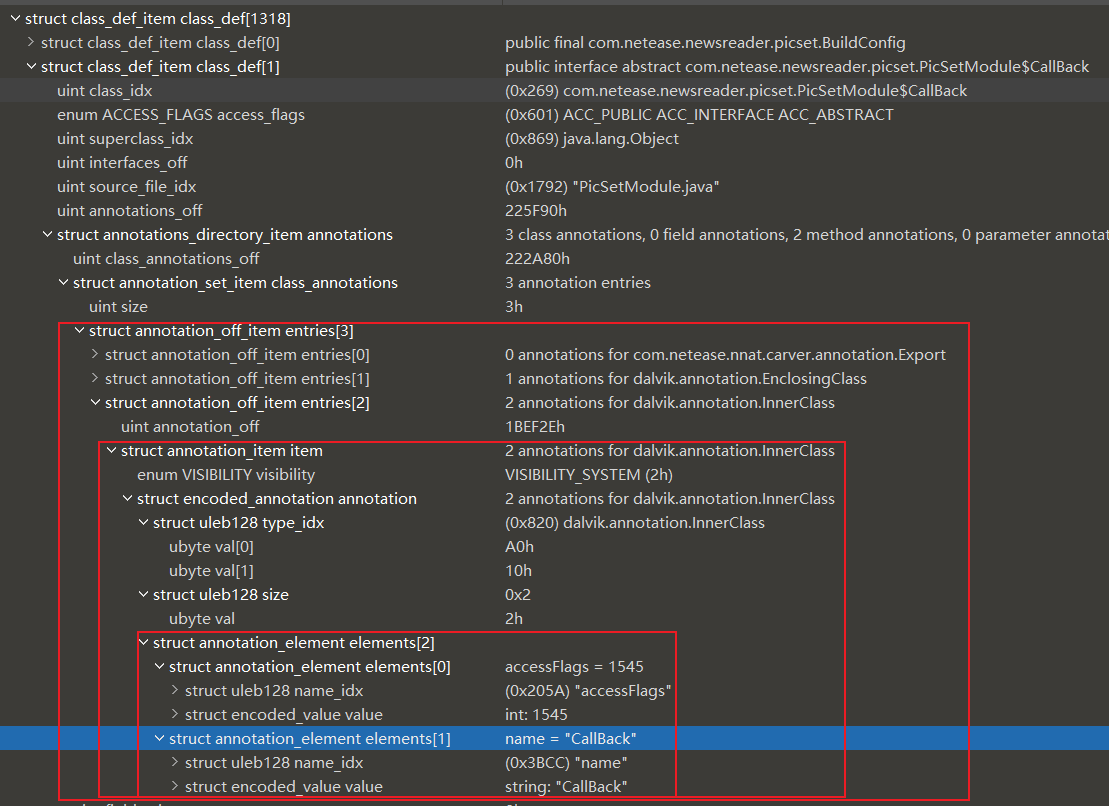
解析代码如下
1
2
3
4
5
6
7
8
9
10
11
12
13
14
15
16
17
18
19
20
21
22
23
24
25
26
27
28
29
30
31
32
33
34
35
36
37
38
39
40
41
42
43
44
45
46
47
48
49
50
51
52
53
|
// Annotation functions
// 将权限修饰符和方法/类名组合
std::string DexFile::combineAccFlagsAndName(std::string accFlags,std::string name) {
std::string result;
if(accFlags.empty())
result=name;//无权限控制关键字,完整名即可
else
result=accFlags+" "+name;
return result;
}
// 打印DexAnnotationItem结构信息
void DexFile::printAnnotation(DexAnnotationItem& annotationItem) {
std::string visibility;//注解可见性
switch(annotationItem.visibility) {
case kDexVisibilityBuild: visibility="build";break;
case kDexVisibilityRuntime:visibility="runtime";break;
case kDexVisibilitySystem:visibility="system";break;
default:visibility="unknown";
}
// 解析encoded_annotation
u1* pAnnotation=annotationItem.annotation;
size_t typeSize=0,sizeSize=0;
u4 encoded_annotation_type_idx=myReadUnsignedLeb128(pAnnotation,&typeSize);//注解类型偏移
u4 encoded_annotation_size=myReadUnsignedLeb128(pAnnotation+typeSize,&sizeSize);//注解name-value映射数
std::string encoded_annotation_type=parseString(getTypeIdDataByIndex(encoded_annotation_type_idx));
//Size Visibility Type
printf("%08d\t%s\t\t%s\n",encoded_annotation_size,visibility.c_str(),encoded_annotation_type.c_str());
// 解析encoded_annotation.elements
u1* pAnnotationElements=pAnnotation+typeSize+sizeSize;
for(int i=0;i<encoded_annotation_size;i++) {
size_t name_idx_size=0;// name_idx
std::string name=parseString(getStringIdDataByIndex(myReadUnsignedLeb128(pAnnotationElements,&name_idx_size)));
size_t valueSize=0;
std::string value=parseString(parseEncodedValue(pAnnotationElements+name_idx_size,valueSize));
printf("\t%s=%s\n",name.c_str(),value.c_str());
}
}
// 打印DexAnnotationSetItem信息 即多个DexAnnotationItem结构
void DexFile::printAnnotationSet(DexAnnotationSetItem& annotationSet) {
printf("Size\t\tVisibility\tType\n");
//AnnotationSetItem.entries[] 数组保存AnnotationItem结构的文件偏移值
for(int j=0;j<annotationSet.size;j++) {
printAnnotation(*(DexAnnotationItem*)(annotationSet.entries[j]+baseAddr));
}
}
// 打印所有类注解 DexAnnotationSetItem
void DexFile::printClassAnnotations(DexAnnotationSetItem& classAnnotations) {
printf("Class Annotations start at %#llx, contains %d entries\n",(uintptr_t)classAnnotations.entries-(uintptr_t)baseAddr,classAnnotations.size);
printAnnotationSet(classAnnotations);
printf("Class Annotations End\n\n");
}
|
效果如下, 打印类注解及其包含的encoded_element内容
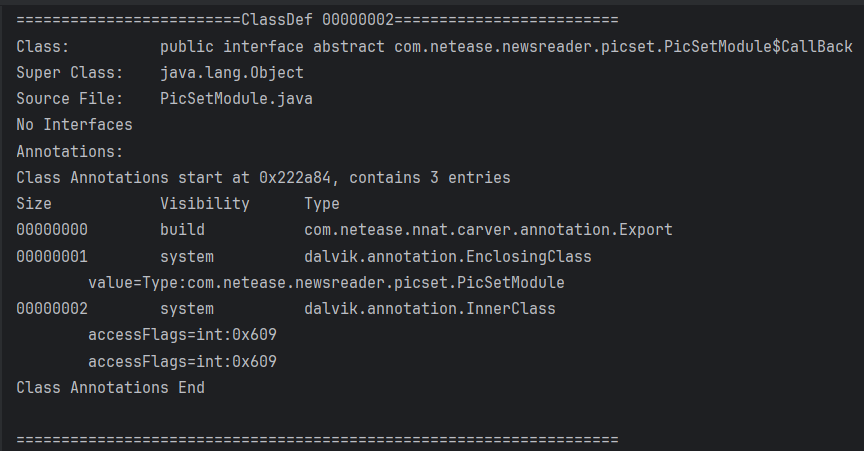
域注解 DexFieldAnnotationsItem
定义如下
1
2
3
4
|
struct DexFieldAnnotationsItem {
u4 fieldIdx; /* 指向DexFieldId列表的索引值 */
u4 annotationsOff; /* DexAnnotationSetItem的文件偏移量 */
};
|
由于指向DexAnnotationSetItem结构,故解析方式和类注解类似
1
2
3
4
5
6
7
8
9
10
|
// 打印所有域注解 DexFieldAnnotationsItem
void DexFile::printFieldAnnotations(DexFieldAnnotationsItem* pFieldAnnotations,u4 fieldsNum) {
printf("Field Annotations start at %#llx, contains %d entries\n",(uintptr_t)pFieldAnnotations-(uintptr_t)baseAddr,fieldsNum);
for(int i=0;i<fieldsNum;i++) {
std::string field=getFieldIdDataByIndex(pFieldAnnotations[i].fieldIdx);
printf("Field%d:\t%s\n",i+1,field.c_str());
printAnnotationSet(*(DexAnnotationSetItem*)(baseAddr+pFieldAnnotations[i].annotationsOff));
}
printf("Field Annotations End\n\n");
}
|
效果如下
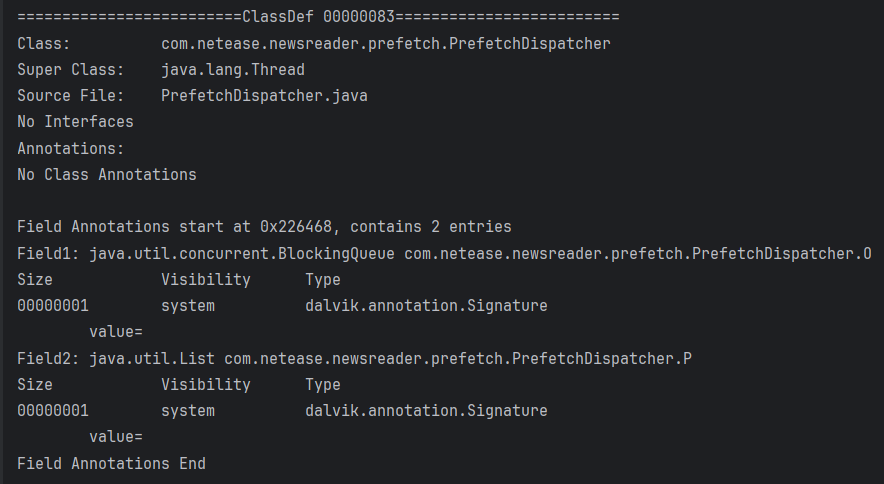
方法注解 DexMethodAnnotationsItem
定义如下
1
2
3
4
5
6
7
|
/*
* Direct-mapped "method_annotations_item".
*/
struct DexMethodAnnotationsItem {
u4 methodIdx; /* 指向DexMethodId列表的索引值 */
u4 annotationsOff; /* DexAnnotationSetItem的文件偏移量 */
};
|
解析方法类似
1
2
3
4
5
6
7
8
9
10
|
// 打印方法注解 DexMethodAnnotationsItem
void DexFile::printMethodAnnotations(DexMethodAnnotationsItem* pMethodAnnotations,u4 methodsNum) {
printf("Method Annotations start at %#llx, contains %d entries\n",(uintptr_t) pMethodAnnotations-(uintptr_t)baseAddr,methodsNum);
for(int i=0;i<methodsNum;i++) {
std::string method=getMethodIdDataByIndex(pMethodAnnotations[i].methodIdx);
printf("Method%d:\t%s\n",i+1,method.c_str());
printAnnotationSet(*(DexAnnotationSetItem*)(baseAddr+ pMethodAnnotations[i].annotationsOff));
}
printf("Method Annotations End\n\n");
}
|
效果如下
参数注解 DexParameterAnnotationsItem
定义如下
1
2
3
4
5
6
7
|
/*
* Direct-mapped "parameter_annotations_item".
*/
struct DexParameterAnnotationsItem {
u4 methodIdx; /* 指向DexMethodId列表的索引值 */
u4 annotationsOff; /* DexAnotationSetRefList的文件偏移量 */
};
|
DexAnotationSetRefList结构体定义如下
1
2
3
4
5
6
7
8
9
10
11
12
13
14
|
/*
* Direct-mapped "annotation_set_ref_list".
*/
struct DexAnnotationSetRefList {
u4 size; /* 列表中元素个数,即DexAnnotationSetRefItem的个数 */
DexAnnotationSetRefItem list[1]; /* 第一个DexAnnotationSetRefItem的内容,非偏移量 */
};
/*
* Direct-mapped "annotation_set_ref_item".
*/
struct DexAnnotationSetRefItem {
u4 annotationsOff; /* DexAnnotationSetItem的偏移量 */
};
|
解析方法略有不同,代码如下
1
2
3
4
5
6
7
8
9
10
11
12
13
14
15
16
17
18
19
20
21
22
23
24
25
26
27
|
// 打印DexAnnotationSetRefList
void DexFile::printAnnotationSetRefList(DexAnnotationSetRefList& annotationSetRefList) {
printf("AnnotationSetRefList contains %d AnnotationSetItems\n",annotationSetRefList.size);
// AnnotationSetRefList.list是AnnotationSetRefItem数组
DexAnnotationSetRefItem* pAnnotationSetRefItem=annotationSetRefList.list;
for(int i=0;i<annotationSetRefList.size;i++) {
if(!pAnnotationSetRefItem[i].annotationsOff) {
printf("No This Annotation Set!\n");//可能存在空项
continue;
}
//AnnotationSetRefItem.annotationsOff指向AnnotationSetItem结构
printAnnotationSet(*(DexAnnotationSetItem*)(baseAddr+pAnnotationSetRefItem[i].annotationsOff));
}
printf("AnnotationSetRefList End\n");
}
// 打印参数注解 DexParameterAnnotationsItem
void DexFile::printParameterAnnotations(DexParameterAnnotationsItem* pParameterAnnotations,u4 parametersNum) {
printf("Parameter Annotations start at %#llx, contains %d entries\n",(uintptr_t) pParameterAnnotations-(uintptr_t)baseAddr,parametersNum);
for(int i=0;i<parametersNum;i++) {
std::string method=getMethodIdDataByIndex(pParameterAnnotations[i].methodIdx);
printf("Method%d:\t%s\n",i+1,method.c_str());
// PatameterAnnotationsItem.annotationsOff指向DexAnnotationSetRefList结构,和其他三个不同
printAnnotationSetRefList(*(DexAnnotationSetRefList*)(baseAddr+pParameterAnnotations[i].annotationsOff));
printf("\n");
}
printf("Parameter Annotations End\n\n");
}
|
效果如下
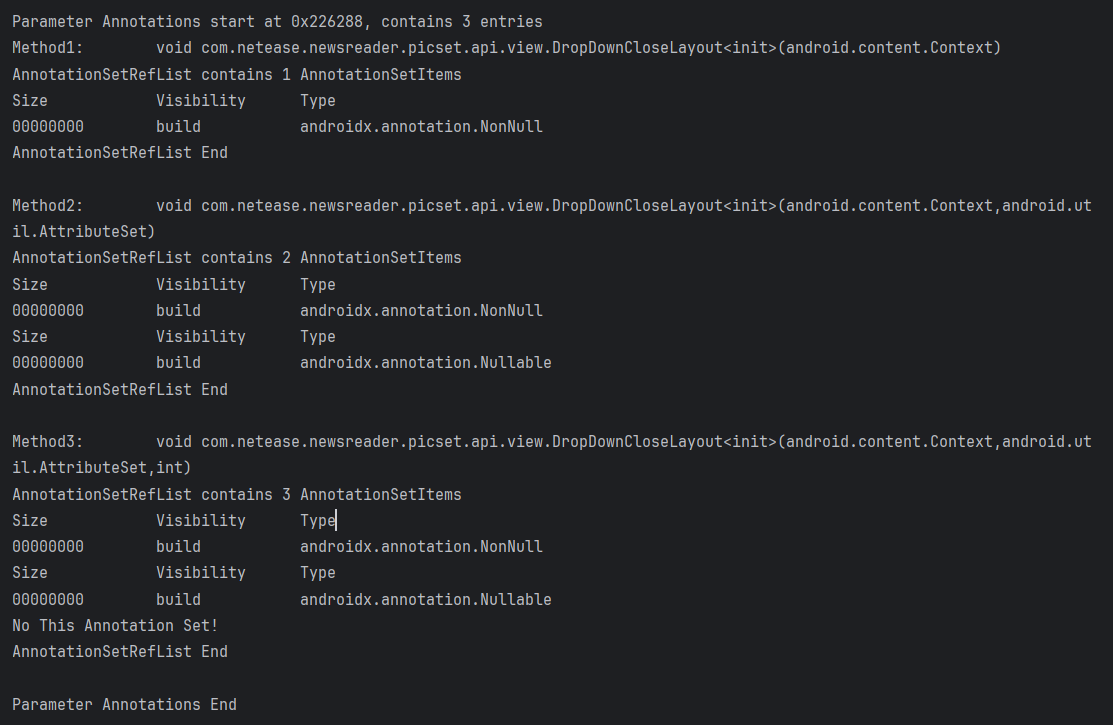
DexClassData
定义在http://androidxref.com/2.3.7/xref/dalvik/libdex/DexClass.h中
注意: DexClass.h定义的结构体中,u4类型实际类型为uleb128
1
2
3
4
5
6
7
8
9
10
|
/* expanded form of class_data_item. Note: If a particular item is
* absent (e.g., no static fields), then the corresponding pointer
* is set to NULL. */
typedef struct DexClassData {
DexClassDataHeader header;
DexField* staticFields; //下面4个连续数组,如果对应长度存在才有效
DexField* instanceFields; //按顺序排列
DexMethod* directMethods;
DexMethod* virtualMethods;
} DexClassData;
|
内部的结构体定义如下:
注意u4均为uleb128,所以这些结构大小不固定,无法通过sizeof计算,需要手动计算
1
2
3
4
5
6
7
8
9
10
11
12
13
14
15
16
17
18
19
20
|
/* expanded form of a class_data_item header */
typedef struct DexClassDataHeader {
u4 staticFieldsSize;
u4 instanceFieldsSize;
u4 directMethodsSize;
u4 virtualMethodsSize;
} DexClassDataHeader;
/* expanded form of encoded_field */
typedef struct DexField {
u4 fieldIdx; /* index to a field_id_item */
u4 accessFlags;
} DexField;
/* expanded form of encoded_method */
typedef struct DexMethod {
u4 methodIdx; /* index to a method_id_item */
u4 accessFlags;
u4 codeOff; /* file offset to a code_item */
} DexMethod;
|
其中codeOff指向DexCode结构,定义如下
1
2
3
4
5
6
7
8
9
10
11
12
13
14
15
16
17
18
19
20
21
|
/*
* Direct-mapped "code_item".
*
* The "catches" table is used when throwing an exception,
* "debugInfo" is used when displaying an exception stack trace or
* debugging. An offset of zero indicates that there are no entries.
*/
struct DexCode {
u2 registersSize; /* 使用的寄存器个数 */
u2 insSize; /* 参数个数 */
u2 outsSize; /* 调用其他方法时使用的寄存器个数 */
u2 triesSize; /* try_item的个数 */
u4 debugInfoOff; /* 指向调试信息的文件偏移量 */
u4 insnsSize; /* 指令集个数,以2字节为单位 */
u2 insns[1]; /* 指令集,insns 数组中的代码格式由随附文档 Dalvik 字节码指定 */
/* 如果 triesSize 不为零,下面存在*/
/* 两字节填充,使下面的try_item实现4字节对齐 */
/* followed by try_item[triesSize],用于表示代码中捕获异常的位置以及如何对异常进行处理的数组 */
/* followed by uleb128 handlersSize */
/* followed by catch_handler_item[handlersSize],用于表示“捕获类型列表和关联处理程序地址”的列表的字节 */
};
|
解析代码如下,
1
2
3
4
5
6
7
8
9
10
11
12
13
14
15
16
17
18
19
20
21
22
23
24
25
26
27
28
29
30
31
32
33
34
35
36
37
38
39
40
41
42
43
44
45
46
47
48
49
50
51
52
53
54
55
56
57
58
59
60
61
62
63
64
65
66
67
68
69
70
71
72
73
74
75
76
77
78
79
80
81
82
83
84
85
86
87
88
89
90
91
92
93
94
95
96
97
98
99
100
101
102
103
104
105
106
107
108
109
110
111
112
113
|
// 打印DexCode Todo: 解析DexCode字段
void DexFile::printDexCode(DexCode& dexCode) {
// 打印基本信息
printf("DexCode:\n");
printf("RegsNum\t\tParamsNum\tOutsNum\t\tTriesNum\tDebugInfoOff\tInsnsNum\tInsnsOff\n");
printf("%08d\t%08d\t%08d\t%08d\t%08x\t%08d\t%08x\n",dexCode.registersSize,dexCode.insSize,dexCode.outsSize,dexCode.triesSize,dexCode.debugInfoOff,dexCode.insnsSize,(uintptr_t)dexCode.insns-(uintptr_t)baseAddr);
// 打印
printf("DexCode End\n");
}
// 打印DexClassData的DexField项目 返回对应数组结构的大小
unsigned int DexFile::printClassDataItem(DexField* pFields,u4 fieldsNum) {
u4 prevFieldIndex=0,offset=0;
for(int i=0;i<fieldsNum;i++) {
DexField* pField=(DexField*)((uintptr_t)pFields+offset);
// 注意由于内部元素为uleb128类型,所以DexField大小并不固定,需要计算
size_t fieldIndexSize=0,accessFlagsValueSize=0;
u4 fieldIndex=myReadUnsignedLeb128((u1*)pField,&fieldIndexSize);
u4 accessFlagsValue=myReadUnsignedLeb128((u1*)pField+fieldIndexSize,&accessFlagsValueSize);
std::string fieldName=getFieldIdDataByIndex(prevFieldIndex+fieldIndex);
std::string accessFlags=parseAccessFlags(accessFlagsValue);
printf("Field%d: %s\n",i+1,combineAccFlagsAndName(accessFlags,fieldName).c_str());
prevFieldIndex+=fieldIndex;// 更新前一个filedIndex
offset+=fieldIndexSize+accessFlagsValueSize;//当前数组结构的偏移
}
return offset;//返回当前数组大小
}
// 打印DexClassData的DexMethod项目 返回对应数组结构的大小
unsigned int DexFile::printClassDataItem(DexMethod* pMethods,u4 methodsNum)
{
u4 prevMethodIndex=0,offset=0;
for(int i=0;i<methodsNum;i++) {
DexMethod* pMethod=(DexMethod*)((uintptr_t)pMethods+offset);
size_t methodIndexSize=0,accessFlagsValueSize=0,codeOffSize=0;// 相比DexField多了codeOff,指向DexCode结构
u4 methodIndex=myReadUnsignedLeb128((u1*)pMethod,&methodIndexSize);
u4 accessFlagsValue=myReadUnsignedLeb128((u1*)pMethod+methodIndexSize,&accessFlagsValueSize);
u4 codeOff=myReadUnsignedLeb128((u1*)pMethod+methodIndexSize+accessFlagsValueSize,&codeOffSize);
std::string methodName=getMethodIdDataByIndex(prevMethodIndex+methodIndex);
std::string accessFlags=parseAccessFlags(accessFlagsValue);
printf("Method%d: %s\n",i+1,combineAccFlagsAndName(accessFlags,methodName).c_str());
if(codeOff) {
printf("CodeOff: %08x\n",codeOff);
printDexCode(*(DexCode*)(baseAddr+codeOff));//打印codeOff指向的DexCode
}
else
printf("No DexCode\n");
prevMethodIndex+=methodIndex;
offset+=methodIndexSize+accessFlagsValueSize+codeOffSize;
}
return offset;
}
// 打印DexClassData
void DexFile::printClassDefClassData(DexClassData& classData) {
printf("ClassData:\n");
// 1.解析DexClassDataHeader 获取各uleb128字段保存的长度
const u1* pClassDataHeader=(u1*)&classData.header;
const u1** pPClassDataHeader=&pClassDataHeader;
u4 staticFieldsNum=readUnsignedLeb128(pPClassDataHeader);
u4 instanceFieldsNum=readUnsignedLeb128(pPClassDataHeader);
u4 directMethodsNum=readUnsignedLeb128(pPClassDataHeader);
u4 virtualMethodsNum=readUnsignedLeb128(pPClassDataHeader);
// pointer指向DexClassDataHeader后方第一个字节(即4个数组的内容),用于后续计算
uintptr_t pointer=((uintptr_t)&classData+unsignedLeb128Size(staticFieldsNum)
+unsignedLeb128Size(instanceFieldsNum)
+unsignedLeb128Size(directMethodsNum)
+unsignedLeb128Size(virtualMethodsNum));
// 2. 解析各个字段(判断是否存在对应字段)
// 注意:
// 1. fieldIdx和accessFlags均为uleb128类型
// 2. 数组首个fieldIndex和methodIndex是正确的,后续index是相对前一个index的偏移值(大部分为1)
// 3. 由于各个结构大小不固定,但是四个数组是连续的,所以要使用offset记录前方数据的大小
unsigned int offset=0;
if(staticFieldsNum) {
printf("ClassData contains %d Static Fields:\n",staticFieldsNum);
offset+=printClassDataItem((DexField*)(pointer+offset),staticFieldsNum);
printf("Static Fields End\n");
}
else {
printf("No Static Field\n");
}
if(instanceFieldsNum) {
printf("ClassData contains %d Instance Fields:\n",instanceFieldsNum);
offset+=printClassDataItem((DexField*)(pointer+offset),staticFieldsNum);
printf("Instance Fields End\n");
}
else {
printf("No Instance Field\n");
}
if(directMethodsNum) {
printf("ClassData contains %d Directed Methods:\n",directMethodsNum);
offset+=printClassDataItem((DexMethod*)(pointer+offset),directMethodsNum);
printf("Directed Methods End\n");
}
else {
printf("No Directed Method\n");
}
if(virtualMethodsNum) {
printf("ClassData contains %d Virtual Methods:\n",virtualMethodsNum);
offset+=printClassDataItem((DexMethod*)(pointer+offset),virtualMethodsNum);
printf("Virtual Methods End\n");
}
else {
printf("No Virtual Method\n");
}
printf("ClassData End\n");
}
|
效果如下
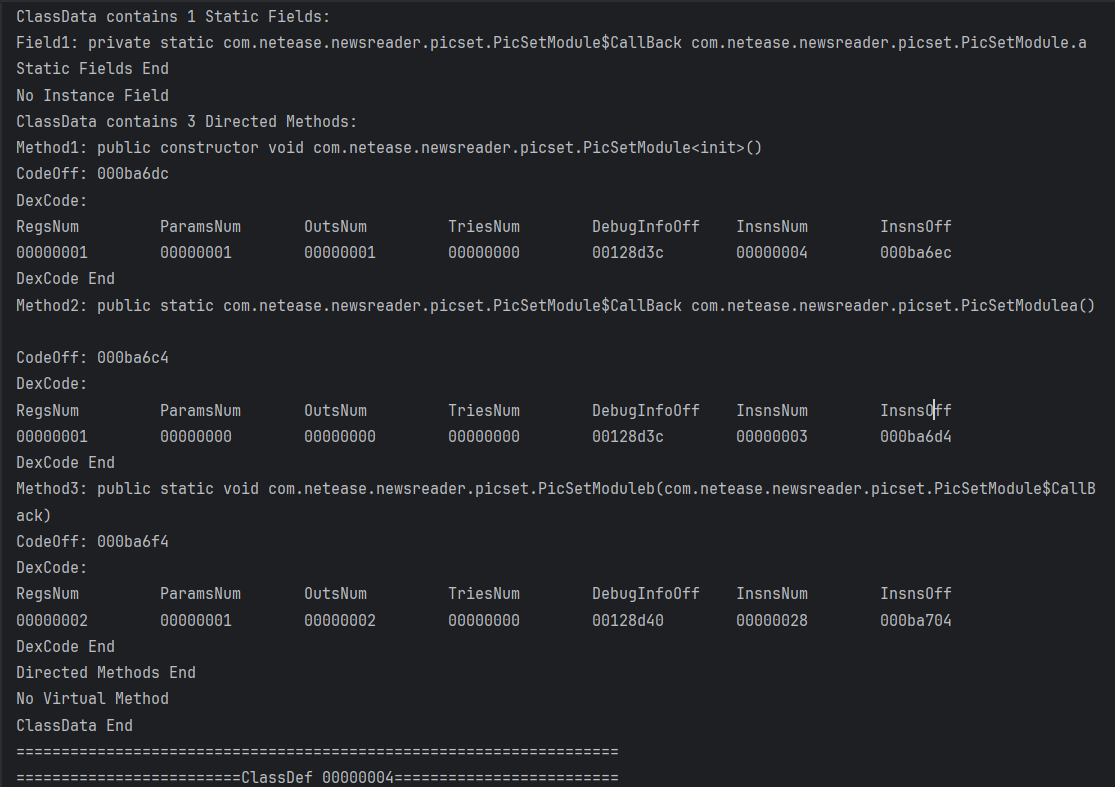
DexEncodedArray
定义如下
1
2
3
|
struct DexEncodedArray {
u1 array[1]; //encoded_array格式的数据
};
|
encoded_array格式定义如下:
| 名称 |
格式 |
说明 |
| size |
uleb128 |
表示数组中的元素数量 |
| values |
encoded_value[size] |
采用encoded_value编码的数据 |
解析代码如下
1
2
3
4
5
6
7
8
9
10
11
12
13
|
// 打印StaticValues 实际为DexEncodedArray结构
void DexFile::printClassDefStaticValues(DexEncodedArray& encodedArray) {
size_t sizeLen=0;
u4 size=myReadUnsignedLeb128((u1*)&encodedArray,&sizeLen);
u1* pValues=(u1*)&encodedArray+sizeLen;
printf("StaticValues contains %d values\n",size);
size_t offset=0,readSize=0;// offset保存前方已访问的结构大小,readSize为单次读取的大小
for(int i=0;i<size;i++) {
printf("%s\n",parseEncodedValue(pValues+offset,readSize).c_str());
offset+=readSize;
}
printf("StaticValues End\n");
}
|
效果如下
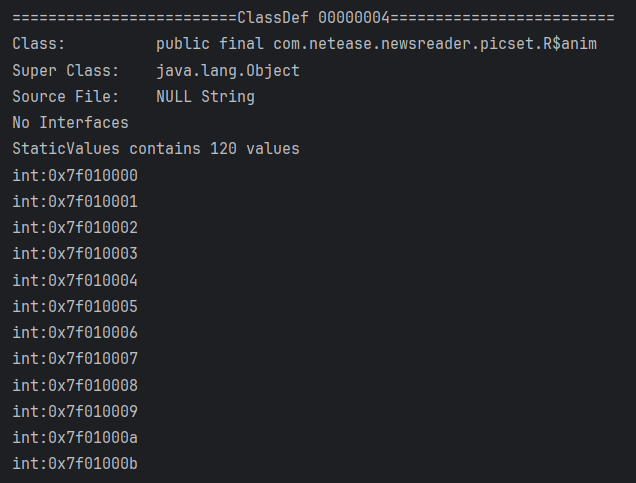
Android系统可执行文件
从JVM到Dalvik再到ART
-
JVM是java语言的虚拟机,运行.class文件
-
Dalvik是google设计的用于Android平台的虚拟机,运行.dex文件
JVM基于栈,DVM基于寄存器,可以做到更好的提前优化,并且运行速度更快
-
Android 4.4首次提出ART虚拟机,在Android 5.0后弃用Dalvik,默认使用ART,运行oat文件
DVM应用运行时,字节码需要通过即时编译器JIT转换为机器码运行
ART则在应用第一次安装时,预先将字节码编译为机器码,该过程称之为预编译(AOT Ahead of time)
DEX
.java文件 经javac编译后生成 .class 文件 再通过dx/d8生成.dex文件
Dalvik虚拟机运行.dex文件,一个apk包内可能含有多个dex文件
ODEX
Android5.0前,使用Dalvik虚拟机,ODEX是Dalvik对Dex文件优化后的产物, 通常存放在/data/dalvik-cache目录下
运行程序时直接加载odex文件,避免重复验证和优化
Android 5.0后,使用ART虚拟机, .odex实际上是OAT文件(ART定制的ELF文件)
OAT
OAT文件是Android4.4中引入的, Android5.0后,系统默认虚拟机为ART
OAT文件即是ART虚拟机对Dex优化后的产物,是Android定制的ELF文件
OAT文件结构随Android版本变化而变化,没有向后兼容性
VDEX
VDEX文件在Android 8.0后引入, 不是Android系统的可执行文件,
Android 8.0后, dex2oat将class.dex优化生成2个文件: OAT文件(.odex)和VDEX文件(.vdex)
- .odex文件包含了本机代码的OAT文件
- .vdex文件包含了原始的dex文件副本
- vdex文件同oat文件一样,随系统版本变化,且没有向后兼容性
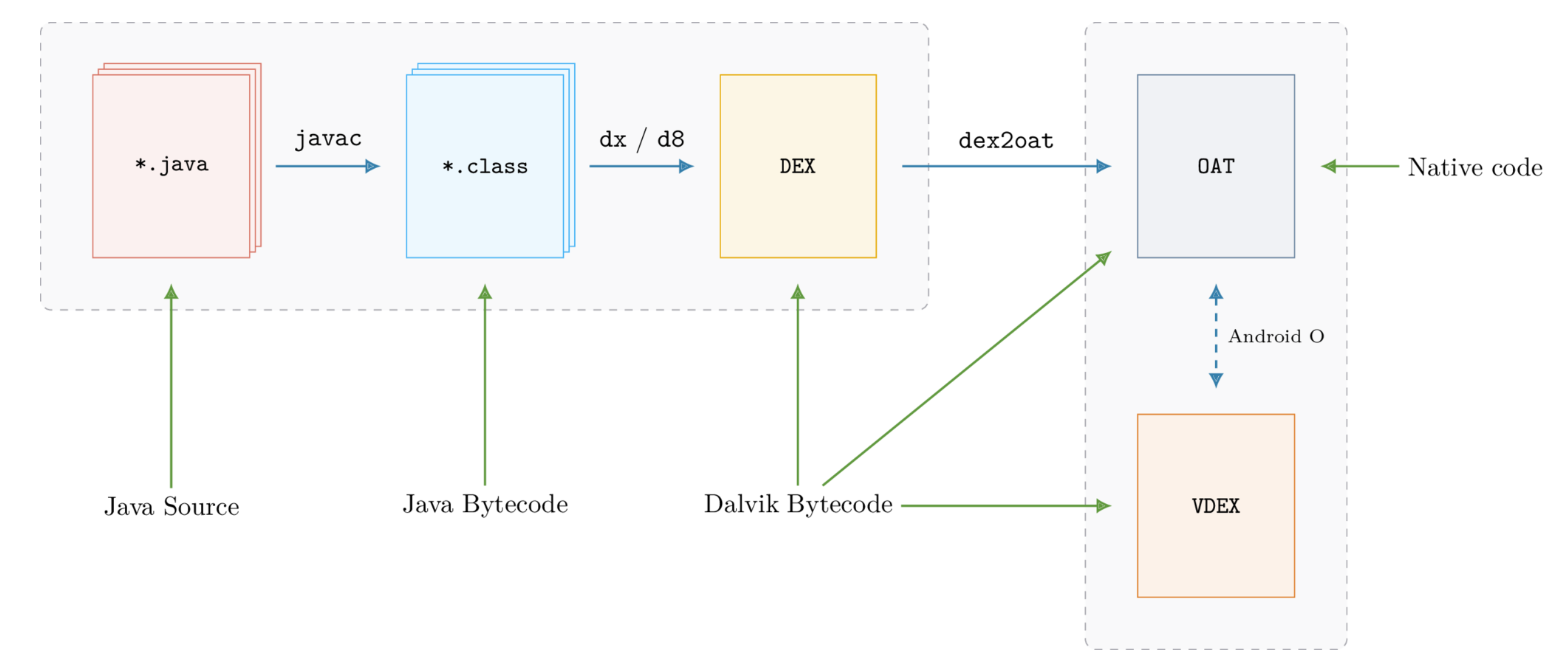
ART
.art文件是一种ELF可执行文件 借助odex文件优化生成, 记录应用启动的热点函数相关地址,便于寻址加速
art文件结构随android版本变化,无向后兼容性
Todo
- 完善encoded_value剩余3个分支解析逻辑
- 绘制Dex文件结构图加深理解
- 整理代码架构
References
Dalvik 可执行文件格式 Android官方文档
Dex文件格式
dex文件格式解析
从JVM到Dalivk再到ART(class,dex,odex,vdex,ELF)
android的dex,odex,oat,vdex,art文件格式
一图全览DEX文件格式






















